
Бесплатный фрагмент - Русский язык для сотрудничества России и Африки (2-е изд.)
Учебник полезен для африканских и русских студентов
Международный проект «Глобальная культура-Русский язык для международной коммуникации»
ЗАО «Гуманитарный фонд»
Группа социально-экономического проектирования Санкт-Петербургского союза учёных
НП «Содействие субъектам науки, просвещения, образования»
сектор Народного художественного университета Санкт-Петербурга
Е. А. Тинякова
РУССКИЙ ЯЗЫК ДЛЯ СОТРУДНИЧЕСТВА РОССИИ И АФРИКИ
Учебник
для говорящих на английском языке в Африке
с культурологическим приложением. 2-е изд.. изм. и доп.
Санкт-Петербург
2025
Учебник рекомендован Группой социально-экономического
проектирования Санкт-Петербургского Союза учёных
Учебник «Русский язык для сотрудничества России и Африки»: учебник для говорящих на английском языке в Африке» является частью Международного проекта «Русский как язык международного общения», и составляет единый комплекс с уже изданными учебниками «Новый страноведческий учебник для преподавания английского языка» и «Учебник русского языка для индийцев через посредство английского языка». Проект задуман автором для расширения включения русского языка в международное общение. Прекрасные образцы русской культуры уже давно завоевали глобальный масштаб в межкультурной коммуникации. Русский язык имеет трудно приводимые в закономерность ситуации в фонетике, грамматике и сложно находимые соответствия лексики при переводе, и это тормозит охват стран в его использовании. Иностранным учащимся надо показать, какое ценное культурное пространство держит русский язык. Поэтому учебник имеет обучающую культурологическую часть в дополнение к базовым основам фонетики, лексики и разговора, грамматики, тренирующей логическое восприятие структуры русского языка. Культурологическая информация учебника кратко знакомит с государственными символами России, географией, природой России, этническим разнообразием страны, календарем праздников и памятных дней, русскими учёными, русской литературой, музыкой, живописью, русскими народными танцами и кратко обычаями. Погрузившись в такую захватывающую атмосферу культуры, учащийся поймёт, что нельзя не знать русский язык, и знать его надо хорошо.
Второе издание учебника русского языка для англоязычной Африки изменено по структуре представления русского языка, также дополнен культурологический блок более подробным рассказом о природе России, традициях, народном менталитете. Изучение русского языка африканскими учащимися может быть в диапазоне уровней В1-С1, и при интенсивном обучение до уровня С2. Поскольку культурологическая часть учебника на оригинальном английском языке, русским учащимся изучающим английский язык, она также может быть полезна для общественно-политического и социо-культурного развития на английском языке. Более того в расширенный культурологический блок было внесено много развивающих упражнений, доводящих русских учащихся до уровня С1-С2 по английскому языку. Обучающий материал учебника открывает широкие перспективы преподавателям и студентам изобретать свои развивающие упражнения.
Е.А.Tinyakova
RUSSIAN FOR PARTNERSHIP OF RUSSIA AND AFRICA
Textbook for English speakers in Africa
with a cultural application,2-nd edition, changed and added
Saint-Petersburg
2025
The textbook is recommended by the Working group
of socio-economic projects of the St. Petersburg Union of Scientists
The textbook «Russian for partnership of Russia and Africa»; for English speakers in Africa» is part of the International project «Russian as a Language of International Communication» and makes a unit with already published textbooks‒ «New textbook of country-studies for learning English» and «Textbook of the Russian language for Indians through the English language». The project was developped by the author to expand the inclusion of the Russian language in international communication. Excellent examples of Russian culture have already won a global scale in intercultural communication. The Russian language has situations in phonetics, grammar that are difficult to bring into correlation with a foreign language and difficult to find lexical matching during translation, and this explains the coverage of countries in its use. Foreign students need to be shown what a valuable culture space the Russian language holds. Therefore, the textbook has a teaching culturological part in addition to the basic foundations of phonetics; vocabulary and conversation, grammar that trains the logical perception of the structure of the Russian language. The culturological information of the textbook briefly introduces Russia’s state symbols, the geography and nature of Russia, the calendar of holidays and memorable days, Russian scientists, Russian literature, music, painting, Russian traditional dancing and customs in brief. Immersed in such an exciting atmosphere of culture, the student will understand that one cannot but know the Russian language, and one must know it well.
The second edition of the textbook «Russian for English-speaking Africa» is changed in structure presenting Russian, also more information about the nature of Russia, Russian traditions and mentality is added. A Russian language textbook is provided for English speakers in Africa, levels B1-C1,C2 is reached by intensive studies. Since the culturological bloc is written in original English, this part of the textbook is useful for Russian students to develop conversational skills on socio-political and socio-cultural topics. The more so as the culturological bloc included many intensive excercises, that may bring Russian learners to Levels C1-C2 in English. The learning material of the textbook is open for teachers and students to invent developing exercises independently.
Оглавление
CONTENTS
1. Why you need to learn Russian
2. Methodical recommendations
3. Types of Russian dictionaries and how to use them
Chapter 1. Entering the Russian language
1.1. Introductory course of phonetics (alphabet, groups
of letters and sounds, syllables to practise distinguishing
sounds; reading rules; about orthoepy, tongue twisters)
1.2. Basic grammar. Morphology: noun, prepositions,
adjective, numerals (counting, dates, time), pronoun,
adverb, verb. Syntax. Punctuation
1.3. Learning to speak in colloquial phrases
1.4. Short thematic texts that will form a dictionary
Chapter 2. Opening Russia
2.1. State symbols
2.2. Briefly about the country of Russia
2.3. Rich nature of Russia……………………………………….
2.4. Public holidays and memorable days in the calendar
of Russia
2.5. Outstanding Russian scientists
2.6. The wealth of the Russian language is its literature
2.7. The world of Russian artists
2.8. Russian classical music
2.9. Russian traditional dances and customs
Chapter 3. Common in the understanding of the world and life
among Russian and English-speaking people (proverbs)
Bibliography
1. Почему
нужно учить русский язык
1. Teaching language
to learners of other languages
(peer-review from a native speaker)
The overall strategy the author encourages and actually employs to teach Russian to speakers of other languages in this text is the Principled Eclecticism. She borrows best practices from the methodologies available and puts them to good use. Among the many techniques available to instructors of teaching language to learners of other languages, are the grammar translation method, the direct method, the audio-lingual method, the Immersion technique, the total physical response, the task based approach, the use of multimedia to enhance the learning experience and the communicative approach. I will endeavour to explain some of these techniques as and when need arises in my interaction with this text.
This text uses a variety of methods and approaches, choosing techniques from each method that she considers effective and apply them according to the learning context and objectives. There is no reliance on one «best method’. This is a plus for this text.
The structure of this text is perfect, language learning/teaching starts with the basics, the vocabulary. The learner is exposed to the preliminaries — the sounds (the presentation of the phonetics of the Russian language sets the goal to reduce the foreign accent to minimum when pronouncing Russian words and phrases), the words and phrases, but what is more, these words are placed in the context of the cultural space — the poems/songs at the start of the book are obligatory a necessary addition. How I wished these songs were given their English equivalents, this would have helped the learners more.
The author could have had her own reasons for leaving out the English print. The provision of Dictionaries at this stage could have been one such good reason. Translation though, is an option too early at this stage, but there is no harm in coming back to these texts, over and over again as the learner gains mastery of the language. The breaking down of teaching units into cultural thematic areas is another strategy the author uses to help with the translation. In terms of methodological application, called upon to bear here is the total immersion strategy (and of course the communicative approach suggested in the Immersion technique). As the name suggests, this is a situation where the learner is immersed in the milieu of the target language as well its culture. The learner is expected to operate in the target language at all times. This is a difficult feat to achieve, unless in a situation where the target language is also the language of instruction in the entire school system.
Aspects of the Audio lingua Method are called to bear in the early stages of the book. This methodology emphasises the use of repetition and therefore habit formation. During these early encounters with the language aspects of repetition to form habits is encouraged. It is important to memorise Russian sentences and phrases… which are supported by understanding in English. Comparison of Russian and English texts will definitely contribute to the expansion of the vocabulary for communication in Russian.
It is worth mentioning another positive characteristics to this text. The author includes all sorts of dictionaries, all to the advantage of the learner. We have among the dictionaries given the explanatory dictionary of the Russian language, dictionaries of synonyms as well as antonyms, the dictionary of phraseological units, the terminological dictionaries, which are in sections such as medical, technical etc. Learning how to use a dictionary is a good starting point to language mastery.
As they say, speaking a bit of the language of the country you are visiting is always a good idea. Locals will appreciate the effort and will respond positively. This text provides the language to use in various practical situations; these include the home situation where for example all the expected activities around the home are covered — from breakfast through to dinner. In between family time, the parents with the children at the play, in the garden — all aspects are covered and in such detail.
The dialogues suggested are phenomenon in their coverage, given both in Russian and in English with such details. Also given in both Russian and English is language as you would need to use at the Railway station, at the Airport and the shop… The learner is never left stranded in whatever situation they find themselves. That is how thorough the book is.
Having ploughed through the text, the course, and now armed with an appreciable knowledge of the Russian language, the learner is given interesting questions in English, but they are expected to answer them in Russian. The author here uses aspects of the communicative approach. This approach is in a way a culmination of the foregoing methods. In this approach focus is on learner ability to communicate various functions, such as asking and answering stated questions, making requests, describing certain actions, narrating given situations and making comparisons. The communicative approach is achieved through task assignment and problem solving — the two key components of critical thinking. The strength of this approach is that learning happens in a context. Grammar is not taught in isolation, but in practical situations. Error correction is not emphasised (and this removes anxiety from the learner), as the understanding is that learners will naturally achieve accuracy through frequent use of, and communicating in the language rather than analysing it.
Teach culture alongside the language. This is strength of this text. Teaching communication is not enough in itself, exposure to the culture from which the language springs, will help the learners not just appreciate the real meaning of the words they are learning, but learn the language with relative ease. The inclusion of the proverbs and sayings of the wise, and its comparison to counterpart proverbs and sayings of the wise in important English speaking countries — Britain and America is highly appreciated. This is the culturological strategy the author recommends. The textbook combines Russian language teaching and intensive acquaintance with the Russian culture.
This book, therefore, positions the teaching of the language in the firm foundation of its context — the Russian culture. With this comes all the beauty of Russia as a country, its beautiful landscape, its colour, its rivers and lakes, its beautiful people, its names, its animals, its beautiful Arts — music, paintings, its folklore and literature, its science and scientists, its seasons etc. The author sums it all when she says: «Immersed in such an exciting atmosphere of culture, the student will understand that one cannot but know the Russian language, and one must know it well».
The learner has no choice but to learn the language for the benefits are immense!
What more can one say, this is a bumper harvest for all you who would want to delve into the teaching of Russian as an international language, and you definitely cannot go wrong.
Enjoy it. Kanyampa Manda19/11/2020.
REFERENCES:
Baylis, P. (2007). Current Approach to Language Teaching and Learning. UWS, Bankstown, NSW, Avstralia.
Bowen, J. D., Madsen, H., & Hilferty, A. (1985). Where we’ve been: insights from the past. InTESOL: Techniques and procedures (pp. 3–30). Boston: Heinle & Heinle.This text provides an informative summary of past language teaching approaches.
Celce-Murcia, M. (2001) Language teaching approaches: An overview. InTeaching English as a second or foreign language (3rd ed., pp. 1–11).Boston: Heinle & Heinle. This text provides an overview of past language teaching approaches with bulleted lists of their main points.
David Nunan, 1991), Language teaching methodology:
a text book for teachers (the Prentice Hall International.
Larsen-Freeman, D. (2000).Techniques and principlesinlanguage teaching (2nd ed.). Oxford, England: Oxford University Press. This volume provides a discussion of the direct method including a sample lesson followed by an analysis of the principles of the method.
Richards, J. C. (2005). Communicative language teaching today. Singapore: RELC,1–44.
Kanyampa Manda. (Рис.1)
BA. English and History-University of Zambia, Honours BA — University of South Africa, MA Literature and languages-Solusi University Zimbabwe.
Teacher: English Language and Literature, Chief Examiner School certificate Literature in English-Zambia.
Author: ReCreation, an anthology of poetry and short fiction — ISBN: 978-7283-8416-0 (sc) /ISBN: 978-1-7283-8420-7 (e) AuthorHouse (Trade mark) UK.
Рисунок 1

Task: Discuss the per-review with students (before studying by the textbook and after completing its study)
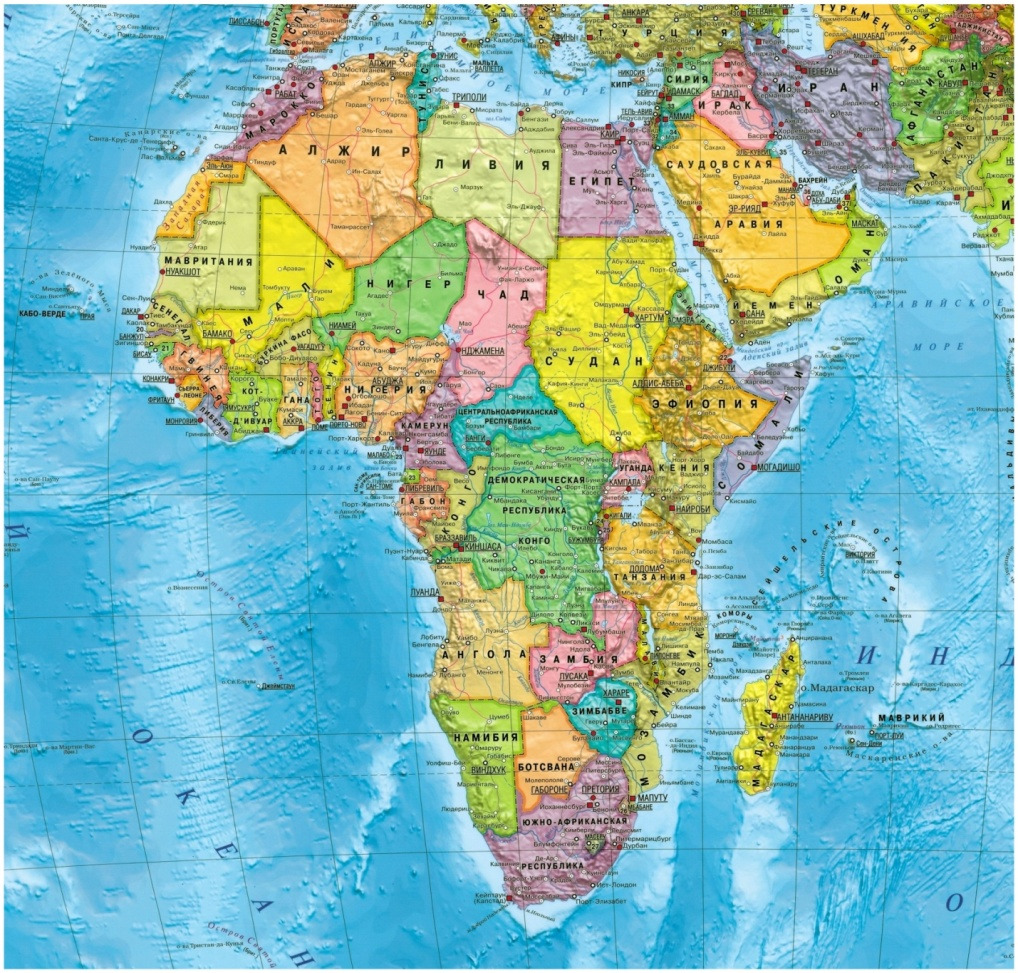
Рисунок 2
History of Africa opened out across our planet
Africa is the largest continent in terms of territory and population (Рис.2). In 2023, it remains one of the most multinational, where representatives of numerous nationalities and ethnic groups live. According to the International Law, there are 54 recognized independent States in Africa. This is the largest number of countries, on the level of state formation, among all the continents.
Africa is striking in its versatility. These are cultural attractions, historical heritage, and natural corners that attract tourists from all over the world.
Africa has gone through a hard period of colonization. The first colonies in Africa were established by the Portuguese in the 16 century. The largest of them were Angola and Mozambique, which had a great potential of natural resources. Great Britain (18 colonies) and France (16) had the largest possessions, but Germany, Spain, Italy, Belgium and Portugal also had colonies.
The process of decolonization of Africa began actively after the Second World War. The Year of Africa — the year of liberation of the largest number of colonies — was declared 1960.
On May 25, Africa celebrates African Liberation Day every year, also known as African Unity Day. (Рис.3)
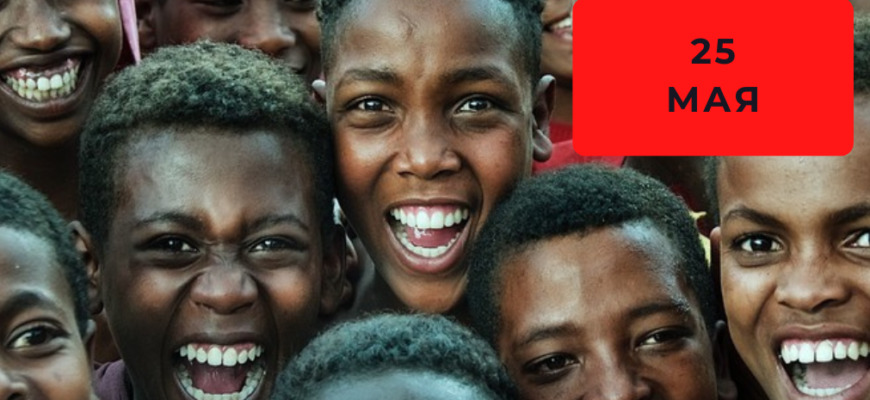
The Day of the Liberation of Africa was established in 1963 on the basis of the decision of the Organization of African Unity, which united African countries in the struggle for independence.
Task: Write an essay «Africa today» (1,5—2 p.)
Oral group discussion «Africa for collaboration with Russia» (look the information below)
Россия имеет три крупных проекта российских компаний в Анголе, Гвинее и Египте, а также образованы советы для успешной работы российского бизнеса в Африке.
Russia has three major projects of Russian companies in Angola, Guinea and Egypt, as well as consulting centers for the successful operation of Russian business in Africa.
Деятельность российских промышленных компаний в Африке осуществляется примерно по 100 направлениям; (Рис.4) их можно классифицировать на пять групп:
— работающие промышленные предприятия, созданные на основе отечественных проектных решений и с использованием отечественного оборудования, в основном в сырьевом, энергетическом и телекоммуникационном секторах;
— строящиеся промышленные объекты с российскими технологиями (например, металлургический Ajaokuta Steel
— в Нигерии, «Российская промышленная зона» в Египте, центр ядерной науки и технологий в Замбии, «Уралхим» с ангольской Grupo Opaia строит завод «Аммиак-карбамид»);
— поставки несырьевой, непродовольственной российской промышленной продукции;
— научно-инжиниринговые услуги (экспертизы, аудит, предварительное и текущие технико-экономические обоснования, испытания, разработки технических проектов и технологических регламентов, обоснование техники безопасности и пр.;
— покупка готовых предприятий.
The activities of Russian industrial companies in Africa are carried out in about 100 areas; they can be classified into five groups:
— operating industrial enterprises created on the basis of domestic design solutions and using domestic equipment, mainly in the raw materials, energy and telecommunications sectors;
— industrial facilities under construction with Russian technologies (for example, the metallurgical Ajaokuta Steel in Nigeria, the Russian Industrial Zone in Egypt, the center of nuclear science and technology in Zambia, «Uralchem» with the Angolan Grupo Opaia is building the Ammonia-Urea plant);
— delivery of non-primary, non-food Russian industrial products;
— scientific and engineering services (expertise, audit, preliminary and current feasibility studies, tests, development of technical projects and technological regulations, safety justification, etc.;
— purchase of ready-made enterprises.
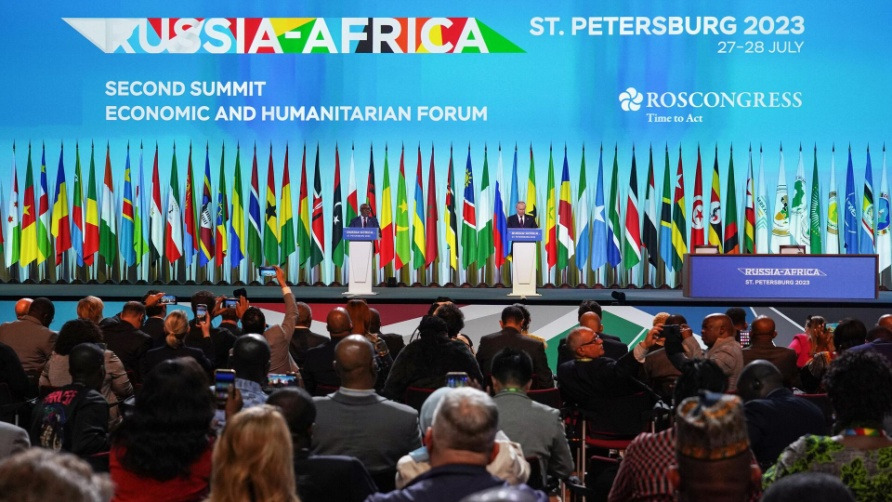
Рисунок 4
Русская духовность в Африке
Russian spirituality in Africa
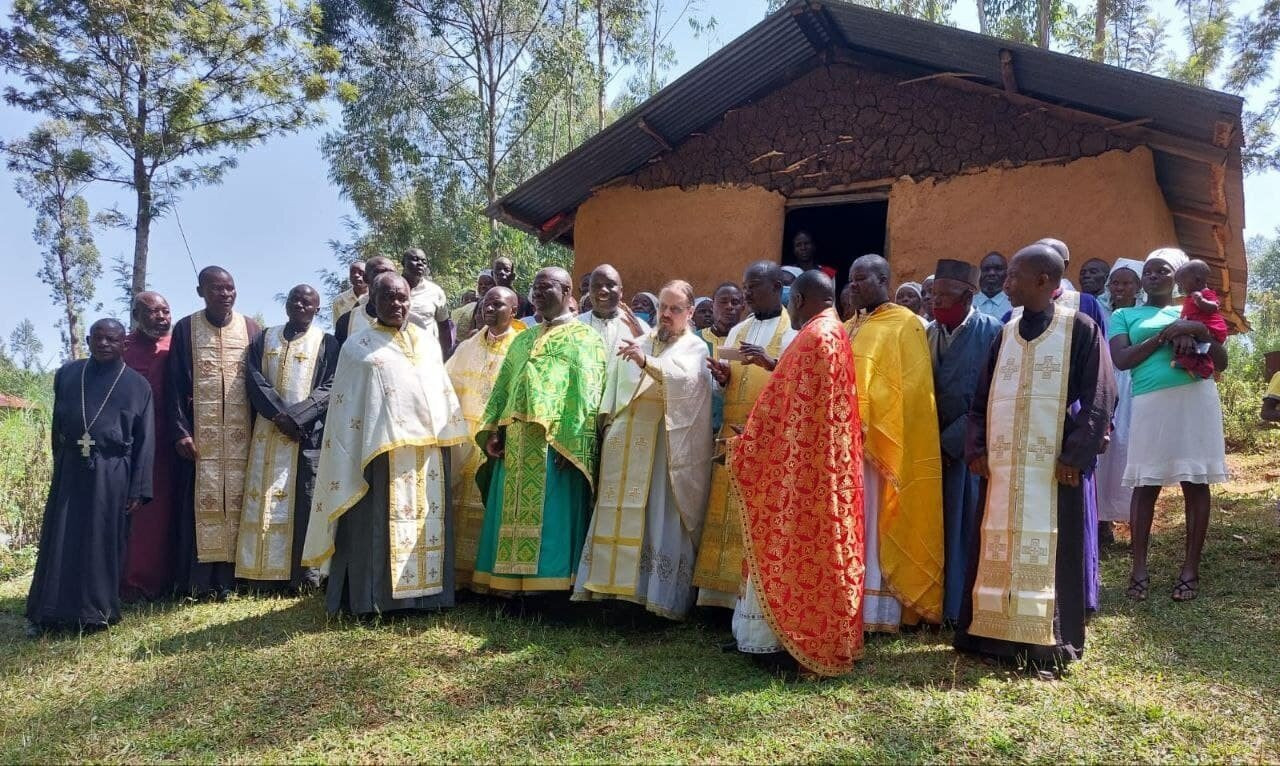
Рисунок 5
Африка — это 1,3 млрд человек населения и 54 страны, неравнодушные к православной вере. (Рис.5).
Экзархат в Африке — Православная церковь.
В декабре 2021 года в Африке открылся Экзархат РПЦ.
Теперь же Русская Церковь ведёт проповедь по всей Африке, где сейчас от 1 до 3 миллионов православных.
В африканских странах растет количество приходов Русской православной церкви. Рядом с храмами строятся школы, детсады, гуманитарные центры.
Africa is 1,3 billion people and 54 countries that are not indifferent to the Orthodox faith.
Exarchate in Africa — Russian Orthodox Church.
In December 2021, the Exarchate of the Russian Orthodox Church opened in Africa.
Now the Russian Church is preaching throughout Africa, where there are now from 1 to 3 million Orthodox.
In African countries, the number of parishes of the Russian Orthodox Church is growing. Schools, kindergartens, humanitarian centers are being built near the temples.
На Втором саммите «Россия-Африка» в Санкт-Петербурге 27 июля 2023 года Святейший Патриарх Московский
и всея Руси рассказал: «Вместе с тем, присутствие Русской Православной Церкви на территории Африки не какая-то беспрецедентная новация. Русские приходы начали появляться на континенте еще в XIX — начале XX века… в Абиссинии в 1889 и 1896 годах были построены русские храмы, а постоянный приход Русской Православной Церкви в Египте был создан в 1914 году. После революции в России… приходов в Африке стало открываться все больше: в 1920 году был освящен храм в Тунисе, в 1922 году был создан приход в Алжире, в 1927 году — открыты русские православные приходы на территории Марокко. В 1998 году мне довелось освящать первый русский храм
в Южно-Африканской Республике».
At the Second Russia-Africa Summit in St. Petersburg on July 27, 2023, His Holiness Patriarch of Moscow and All Russia said: «At the same time, the presence of the Russian Orthodox Church in Africa is not some unprecedented innovation. Russian parishes began to appear on the continent back in the 19th — early 20th centuries… in Abyssinia, Russian churches were built in 1889 and 1896, and the permanent parish of the Russian Orthodox Church in Egypt was created in 1914. After the revolution in Russia… more and more parishes began to open in Africa: in 1920 a temple was consecrated in Tunisia, in 1922 a parish was created in Algeria, in 1927 Russian Orthodox parishes were opened in Morocco. In 1998, I had a chance to consecrate the first Russian church in the Republic of South Africa».
Русская православная церковь расширяет присутствие на африканском континенте. Ее миссионеры уже охватили 23 страны, в которых служат более 200 клириков, подчиняющихся РПЦ.
Патриарший экзархат Африки начал 2024 год с самого масштабного выезда священнослужителей Русской православной церкви в разные страны африканского континента.
The Russian Orthodox Church is expanding its presence on the African continent. Her missionaries have already covered 23 countries in which more than 200 clerics subordinate to the Russian Orthodox Church serve.
The Patriarchal Exarchate of Africa began 2024 with the largest exit of the clergy of the Russian Orthodox Church to different countries of the African continent.
Экзархат Африки состоит в тесном сотрудничестве с Министерством просвещения, Министерством науки и высшего образования, Министерством здравоохранения, с Россотрудничеством, естественно, с Министерством иностранных дел совместно разрабатываются мощнейшие программы по Африке, которые уже начинают во многих странах реализовываться.
The Exarchate of Africa is in close cooperation with the Ministry of Education, the Ministry of Science and Higher Education, the Ministry of Health, Rossotrudnichestvo, of course, the Ministry of Foreign Affairs and it is jointly developing the most powerful programs in Africa, which are already beginning to be implemented in many countries.
В 2023 году в 28 африканских странах совместно с 14 российскими педагогическими вузами начали работу центры открытого образования на русском языке. Такие Центры работают в Алжире, Анголе, Гане, Египте, Зимбабве, Мадагаскаре, Мозамбике, Республике Конго, Тунисе, Уганде, Эфиопии, ЮАР. В планах сотрудничества вовлекать юных жителей африканских стран эффективно изучать русский язык, участвовать в российских олимпиадах, конкурсах, мероприятия. В целом рассматривается широкое сотрудничество России с африканскими коллегами по линии образования.
В 2024 году открыты еще 4 русские школы в Африке. In 2023, Russian Open Education Centers began operating in 28 African countries, together with 14 Russian pedagogical universities. Such Centers operate in Algeria, Angola, Ghana, Egypt, Zimbabwe, Madagascar, Mozambique, the Republic of Congo, Tunisia, Uganda, Ethiopia, and South Africa. Cooperation plans include involving young residents of African countries to effectively learn the Russian language, participate in Russian olympiads, competitions, and events. In general, broad cooperation between Russia and African colleagues in the field of education is being considered. In 2024, 4 more Russian schools were opened in Africa.
Язык — это история народа. Язык — это путь цивилизации и культуры. Поэтому-то изучение и сбережение русского языка является не праздным занятием от нечего делать, но насущной необходимостью.
А. И. Куприн, известный русский писатель
Language is the history of a people. Language is the path of civilization and culture. Therefore, the study and preservation of the Russian language is not an idle occupation with nothing to do, but an urgent need.
Kuprin A.I., famous Russian writer
Русский язык — это не сложно. Его нужно понимать. Если это предложение верно для русского, оно верно и для всех языков, потому что «трудность» всегда относительна: интерес, преданность, любовь, настойчивость, страсть, время, предрасположенность и т. д.…
Тинякова Елена, автор учебника
Дзанарелла Паоло, деятель культуры Италии
The Russian language is not difficult. You have to understand it. If this sentence is true for Russian, it is true for all languages, because «difficulty» is always relative: interest, devotion, love, persistence, passion, time, disposition, etc…
Tinyakova Elena, the author of the textbook
Zanarella Paolo, great figure in culture of Italy
Historical ties between Russia and Africa
The Russian Empire, as compared with other European powers, did not seek to colonize the territory of Africa. At a certain period of history, the Russians did try to establish themselves in Africa to some extent. It would be more accurate to say that it was done by a group of people from Russia, and not Russia as a state.
Peter the Great made his first attempt to make an establishment in Africa. On the island of Madagascar, he wanted to make a parking port for Russian ships. The first attempts to establish ties with Africa date back to the 18-th century — a letter from Peter I to the «Madagascar king» has been preserved. But this business stopped with the death of the tsar.
Catherine II entered into correspondence with the Moroccan Sultan a few decades later.
For some time, the Russian state was very indifferent to Africa in the 19 century. The state interest was concerned about the tasks of expanding to the East — the Caucasus, Central Asia, Primorye. Travels under the auspices of the Russian Geographical Society to Africa began only in the 1870s, and Vasily Junker became one of the pioneers in the discovery of the Black continent. In 1875–1886 he made two long trips to the region of today’s South Sudan and the CAR, which by that time remained a solid white spot on the map of Africa.
In the first two months of 1889, a group of one hundred and fifty Cossacks reached a village in East Africa, which is now called Djibouti (at that time it was known as French Somaliland, and later the French territory of Afar and Issa). Their main goal was to establish a Russian colony called «New Moscow», which would form a springboard to build relations between the Russian Orthodox and the Ethiopian Orthodox Churches.
The most famous Russian African is Pushkin’s great-grandfather, the Arab Abram Hannibal. However, he probably did not originate from Ethiopia, as Pushkin himself believed, but from the Kotoko people, who live to this day on the shores of Lake Chad. This is evidenced, among other things, by linguistic facts.
The lack of Russian political interest in Africa predetermined the purely scientific nature of travel, which in the 19 century also had
a strong artistic and romantic character and goals.
Ethiopia has always been of interest to the Russian Empire. In January 1895, the Russian expedition of Nikolai Leontiev arrived to the oldest independent state of Africa, it began as a research expedition, but turned into a diplomatic matter. As a result of Leontiev’s meeting with Negus Menelik II, it was decided to establish diplomatic relations between the two countries. In January 1896, Leontiev returned to Ethiopia and became Menelik’s military adviser during the Italian-Ethiopian War, during which the colonizers were defeated with the help of Russian weapons, and Ethiopia retained its independence.
Many Russian volunteers fought in the Anglo-Boer War of 1899–1902 on the side of the Boers.
During the second half of the 19th century, Russian consulates were opened in the North African countries controlled by Europeans — Morocco, Algeria, Tunisia and Egypt.
The Russian Empire hoped to enlist the support of the rulers of Morocco, Egypt and Tunisia in the confrontation with the Ottoman Empire. In 1869, diplomatic relations were established with Tunisia, in 1897 — with Morocco, in 1898 — with Ethiopia and the state of the Boer Afrikaners — the Transvaal Republic.
The Russian Black Sea Fleet, which left Sevastopol after the defeat of the «white movement» during the revolution that began in 1917, was evacuated in 1920 to the Tunisian Bizerte.
Russian consulates worked until 1924, and thousands of Russian emigrants scattered through the cities of North Africa, some of whom gained fame in their new homeland.
After the October Revolution of 1917, Russian-African relations practically did not develop; only in 1943 did the Soviet Union manage to establish official relations with Egypt and Ethiopia.
The USSR initiated the adoption the Declaration on the Granting of Independence to Colonial Countries and Peoples by the UN General Assembly in 1960. As African countries gained independence and developed contacts with the USSR, the Soviet country consistently defended their interests in the UN. In particular, in 1973, the UN General Assembly adopted the Convention on the Suppression and Punishment of the Crime of Apartheid, proposed by the USSR jointly with Guinea.
In total, the USSR concluded agreements on economic and technical cooperation with 37 African countries. On their basis, Soviet specialists participated in the creation of about 600 enterprises and other facilities in Africa, of which more than 300 were put into operation by the end of the 1980s. With the assistance of the USSR, about 500 thousand African specialists and skilled workers were trained.
After the collapse of the USSR and the reorientation of socialist African states towards cooperation with European countries and the United States, Russian-African ties practically did not develop for a long time. However, during this period relations with South Africa were normalized.
The intensification of bilateral contacts with other African states began only in the late 1990s.
The first Russia-Africa Summit in 2019 made it possible to return Russian-African relations to the center of priorities between Moscow and the African continent.
Task: Make up a plan “ Africa in Russian history».
2023 is the year that has become one of the most successful in Russian-African relations in recent decades.
Russia plans to ensure maximum representativeness in Africa.
On July 27–28, 2023, a Summit of African leaders was held with the participation of Russian President Vladimir Putin in St. Petersburg.(Рис.4).The event was held on the basis of Expoforum. 17 countries were represented at the level of heads of State. Another 10 African states sent prime ministers to the event in St. Petersburg. Almost half of the summit participants sent delegations at a lower level: 17 of them are headed by deputy prime ministers and ministers, and five are just ambassadors.
Within the framework of the business program of the Second Summit and the Economic and Humanitarian Forum, Russia and Africa discussed the goals and tasks facing Russia and African countries in the era of global change. The issues were discussed by representatives of relevant ministries of the Russian Federation, Russian and African businessmen, experts in the field of international relations.
In addition, the Forum participants touched upon the most pressing problems and ways to solve them to stimulate the development of Russian-African relations in the economic, cultural and humanitarian spheres.
Russia is exploring the possibility of expanding its diplomatic presence in Africa; it plans to open embassies in Niger, the Republic of South Sudan and Sierra Leone.
В каких странах Африки используется английский язык (Рис.6):
Нигерия;
Эфиопия;
Южная Африка;
Танзания;
Кения;
Судан;
Уганда;
Гана;
Камерун;
Малави;
Замбия;
Зимбабве;
Ботсвана.
Which African countries use English:
Nigeria;
Ethiopia;
South Africa;
Tanzania;
Kenya;
Sudan;
Uganda;
Ghana;
Cameroon;
Malawi;
Zambia;
Zimbabwe;
Botswana.
Task: tell orally and in written form about one of the African countries.
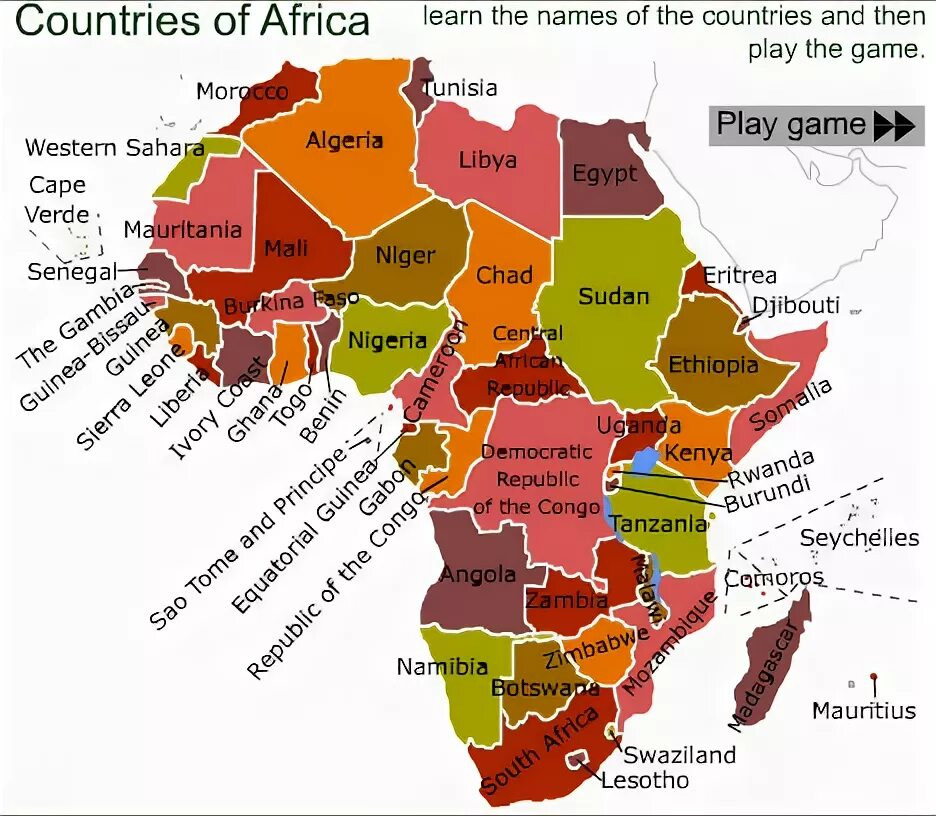
Рисунок 6
Российская образовательная система сегодня лидирует в растущей глобальной конкуренции за африканских студентов.
По данным на ноябрь 2024 года больше всего заявок на обучение в российских вузах из стран Африки подали абитуриенты из Алжира, Анголы, Египта, Мали и Чада.
В российских университетах обучается 35 000 студентов из Африки, около половины из которых — 15 668 — граждане Египта. У студентов из Египта посредником адаптации к учёбе в России является английский язык!
В десятку стран, студенты которых также выбрали обучение в России, вошли Марокко, Нигерия, Алжир, Зимбабве, Тунис, Камерун, Конго, Ангола и Кот-д’Ивуар.
У африканских студентов наиболее популярны профессии медицинского, экономического, инженерного профилей.
В Российском университете дружбы народов (РУДН) учится наибольшее число африканцев — 2500 студентов из 54 государств этого континента. В 2022/2023 учебном году в университет поступило больше всего студентов из Египта, Нигерии, Замбии, Алжира и Анголы.
The Russian educational system leads the growing global competition for African students today.
As of November 2024, the largest number of applications to study at Russian universities from African countries were submitted by applicants from Algeria, Angola, Egypt, Mali and Chad.
There are 35,000 students from Africa studying at Russian universities, about half of whom — 15,668 — are Egyptian citizens. For students from Egypt, the mediator of adaptation to studying in Russia is English!
The top ten countries whose students chose to study in Russia included Morocco, Nigeria, Algeria, Zimbabwe, Tunisia, Cameroon, Congo, Angola and Cote d’Ivoire.
The most popular professions among African students are medicine, economics, and engineering.
The Peoples’ Friendship University of Russia (RUDN) has the largest number of Africans studying — 2,500 students from 54 countries of this continent. In the 2022/2023 academic year, the university received the most students from Egypt, Nigeria, Zambia, Algeria and Angola.
The Russian language welcomes African students for successful professional studies! Learn Russian by this textbook and put your English aside. The Russian language will help you to bring good professional knowledge and skills to Africa! You are to pave the way to higher social and economic standards in your native country in Africa!
1. Почему нужно учить русский язык.
Стихи о русском языке
1. Why you need to learn Russian.
Poems about the Russian language
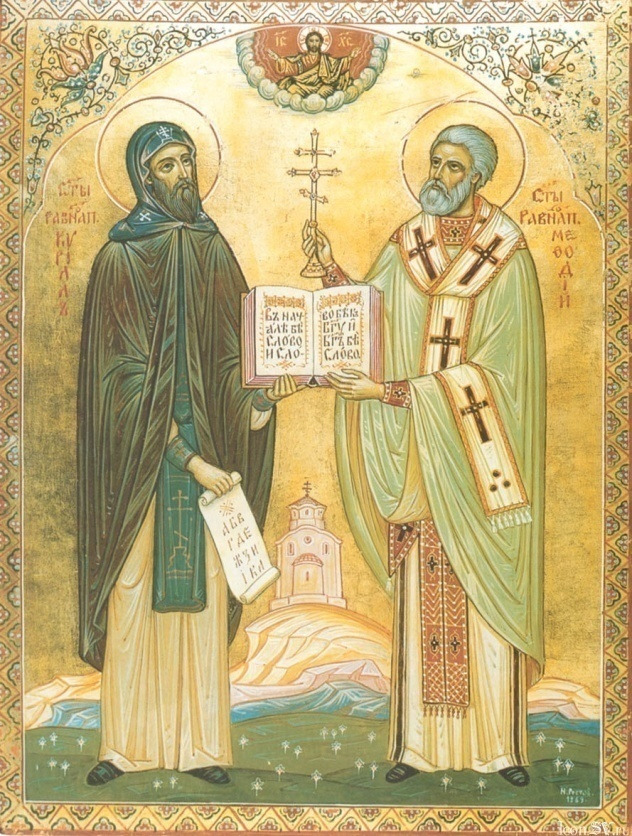
Славяне, жившие более 1100 лет назад в государстве Великая Моравия (территория многих современных европейских государств — Венгрии, Словакии, Чехии, часть Польши и Украины) общались на непонятном каждому народуязыке и не имели письменности. Великоморавский князь Ростислав пригласил в 863 году двух учёных монахов Кирилла и Мефодия (Рис. 7), которые жили в самом сильном и богатом государстве того времени — Византии, оно было приблизительно там, где расположены современные страны Греция и Турция. Византия славилась своими учёными не меньше, чем богатством и армией. Язык, на котором говорили в этом государстве, был греческий. С него братья, создав алфавит на основе греческого тайного письма, перевели на моравский язык Священное Писание и церковные книги. Буквами, объединёнными в алфавит, созданными Кириллом и Мефодием и их учениками, стали записывать не только церковные книги, но и летописи, письма, хозяйственные документы — одним слово, всё, в чём возникала необходимость. Эти буквы называются «Кириллицей». А современныйанглийский язык использует буквы «латиницы».
The Slavs who lived more than 1100 years ago in the state of Great Moravia (the territory of many modern European states — Hungary, Slovakia, the Czech Republic, part of Poland and Ukraine) communicated in a language incomprehensible to every nation and did not have a written language. The Great Moravian prince Rostislav invited in 863 two learned monks Cyril and Methodius (Рис. 8), who lived in the most powerful and richest state of that time — Byzantium, it was approximately where the modern countries of Greece and Turkey are located. Byzantium was famous for its scientists no less than for its wealth and army. The language spoken in this state was Greek. From it, the brothers, having created an alphabet based on the Greek secret writing, translated the Holy Scriptures and church books into the Moravian language. Letters combined in the alphabet, created by Cyril and Methodius and their students, began to be used not only in church books, but also archive notes, letters, business documents — in one word, everything that arose the need for. These letters are called «Cyrillic». And modern English uses the letters «Latin».
День памяти святых Кирилла и Мефодия 24 мая по новому стилю.
Старославянский — язык древнейших дошедших до нас памятников X–XI веков, а также язык переведённых с греческого Кириллом и Мефодием церковных книг считается первым литературным языком славян. Продолжением старославянского как литературного языка был церковнославянский язык. Древнерусский — это общий язык восточных славян, сформировавшийся в VII–VIII вв. и просуществовавший до XIV–XV вв., когда распался на три языка: русский, белорусский и украинский.
Day of Remembrance of Saints Cyril and Methodius is May, the 24-th in the new style.
Old Church Slavonic is the language of the oldest survived papers of the Xth-XIth centuries, as well as the language of church books translated from Greek by Cyril and Methodius; it is considered the first literary language of the Slavs. The development of the Old Church Slavonic as a literary language was the Church Slavonic language. Old Russian is a common language of the Eastern Slavs, formed in the VIIth-VIIIth centuries and existed until the XIV — XV centuries, when it broke up into three languages: Russian, Belarusian and Ukrainian.
Примечание: Все познавательные и объяснительные тексты с параллельным английским переводом рекомендуется сравнивать. Это тоже полезный обучающий приём. Рекомендуется заучивать наизусть русские предложения, фразы из таких текстов, которые подкреплены пониманием на английском языке. Такое сравнение русского и английского текстов будет способствовать и расширению словаря для коммуникации на русском языке, понятые русские слова рекомендуется записывать в словарь для лучшего запоминания и анализировать их структуру через представленные правила грамматики русского языка, чтобы знать исходную форму слова, потому что в памяти должна храниться исходная форма слова, которая будет применяться с усвоенной грамматикой.
Note: It is recommended to compare all information-containing and explanatory texts with parallel English translation. This is also a useful teaching technique. It is recommended to memorize Russian sentences, phrases from such texts, which are supported by understanding in English. Such a comparison of the Russian and English texts will also contribute to the expansion of the vocabulary for communication in Russian, it is recommended to write down understood Russian words in the dictionary for better memorization and analyze their structure through the presented grammar rules of the Russian language in order to know the original form of the word, because it must be stored in memoryand then applied according to the grammar learned.
Русский язык
Я люблю свой родной язык!
Он понятен для всех,
Он певуч,
Он, как русский народ, многолик,
Как держава наша, могуч.
Он язык луны и планет,
Наших спутников и ракет.
На совете за круглым столом
Разговаривайте на нём:
Недвусмысленный и прямой,
Он подобен правде самой.
Ф. Тютчев
Русский язык
С кириллицы начав родное слово,
И изучив его от А до Я,
Нет лучшего, чем языка родного,
Пока звучит родимая земля.
Она звучит Есенина стихами,
Здесь Маяковский, словом режет звук,
Любимый Пушкин ежедневно с нами,
И Фет, и Тютчев, с ними нет разлук!
А сколько в прозе русского звучанья,
Толстой и Гоголь, Шолохов, друзья,
Ведут нас, словом к радости сознанья,
Что русские они все, как и я!
Благодарю Мефодия, Кирилла
За буквы, звуки, благозвучность слов,
Что к языку нам русскому привили
Огромную, бескрайнюю любовь!
Анна Ахматова
Язык наш прекрасный
Язык наш прекрасный —
Богатый и звучный,
То мощный и страстный,
То нежно-певучий.
В нём есть и усмешка,
И мягкость, и ласка.
Написаны им
И рассказы, и сказки.
Страницы волшебных,
Волнующих книг!
Люби и храни
Наш великий язык! Н. Пикулёва
2. Методические рекомендации
2. Methodical recommendations
Методика включения обучающегося по этой книге русскому языку ставит задачу через представление ключевых характеристик русского языка вывести на широкое пространство русского языка. Этим объясняется новый жанр учебника — «учебникс культурологическим приложением», то есть опора практики освоения русского языка на большой культурологический блок, включающий географическое и административное представление России, литературу, живопись и музыку из глубины истории. Учебник соединяет обучение русскому языку с интенсивной познавательностью о русской культуре.
Практическая сторона изучения русского языка соответствует базовым лингвистическим наукам: фонетике и орфоэпии, морфологии и частично орфографии, синтаксису, пунктуации. Культурологический блок знакомит также с русской лексикографией, то есть типами словарей и кратко советует, как ими пользоваться.
В разделе «Вводно-фонетический курс» автор книги сравнила и объяснила варианты представления звуков русского языка латиницей. Здесь нужно обратить внимание на рекомендуемую автором латиницу для русского алфавита. Она наиболее чётко дифференцирует звуки, трудно воспринимаемые иностранцами — Е,Ё,Я,Ю,И,Э и Й. Путаница в применениилингвистами знаков латиницы — J и Y — может мешать и запоминанию слов. Одним словом представление фонетики русского языка ставит цель до минимума снизить иностранный акцент при произношении русских слов и фраз. Для этого даются скороговорки, правила чтения, а в конце книги–пословицы, то есть твёрдо усвоенные фразы. Относительно орфоэпии, автор более стремится научить фокусировать слово либо проставленным ударением, либо найденным в словаре. А после достаточной практики ударение в русских словах уже определяется по «чувству языка», то есть идёт не от правил. И поддаётся синергетическому приёму, то есть «самопостановке».
Морфология даётся кратко, базово. Автор книги старается минимально загружать обучающихся правиламии больше мыслить по аналогии от типичных примеров. После такого, можно сказать, «матричного представления русской грамматики», идёт переход к коротким текстам. И если тексты культурологической тематики сопровождаются переводом (здесь тоже применяется сочетание перевода фрагмента текста и подача слов для самостоятельного формирования перевода на русский язык), то обучающие короткие тематические тексты предлагаются для понимания через применение слов для перевода. Эти тексты утверждают основные тематические пласты для повседневного разговора. Их лучше заучивать наизусть. А потом повторять предложения в другом порядке, изменяя для возможной проектируемой ситуации. Слова к коротким тематическим текстам даются в исходной форме. Поэтому изучающие русский язык могут сравнивать эти исходные формы из списка слов к тексту с грамматически изменёнными словами в текстах, и сопровождать это сравнение правилами из Главы по основам грамматики.
Разговорные фразы тоже предлагаются по коммуникативным ситуациям. Их, безусловно, лучше заучивать наизусть. Для усиления памяти, чтобы она не была просто механической, в построении фраз нужно усматривать представленную грамматику. Как можно понять, русская грамматика даётся не от теоретических основ, а от практического опыта.
Стилистика, как ветвь обучения русскому языку, отдельно не представлена. Потому что это уже более высокий уровень приобретения лингвистического опыта. Однако, чтение культурологических текстов может дать некоторый опыт.
И в заключение автор даёт три совета по интенсификации памяти при изучении русского языка. Это неожиданность, естественность и быстрота. «Неожиданность» предполагает вспоминать усваиваемый материал в неподготовленной ситуации. «Естественность» должна давать оттенок свободы воспроизведения, то есть применение без напряжения, как в обычных условиях разговора, пользования русским языком. «Быстрота» должна тренировать на как можно скорое извлечение из памяти того, что изучено.
При соблюдении этих трёх правил успех коммуникации на русском языке обеспечен, его объём только будет зависеть от количества усвоенной лексики.
Отличие методики русского автора от международных, более британских методик, преподавания английского языка в том, что тренировка языка не размельчена на многочисленные упражнения, которые идут от инициативы преподавателя. Русский автор представляет безошибочное употребление русского языка грамматическим, фонетическими схемами, логически организованными, а изучающий сам может придумывать себе различные упражнения. То есть инициатива учащегося не загружена упражнениями учителя, безусловно, упражнения русский автор даёт. И главное — решается труднейшая проблема обучения неродному языку: соответствие смысловых полей лексических единиц. Студент может сравнить одновариантный перевод слова в прилагаемом к тексту словаре с нахождением в переводе текста целиком−могут быть различия.
2. Methodical recommendations
The method of including the student into learning Russian sets the task to bring it to the wide space of the Russian language through the presentation of the key characteristics of the Russian language. This explains the new genre of the textbook — «a textbook with a culturological application», that is, the support of the practice of mastering the Russian language by a large culturological block, including the geographical and administrative representation of Russia, literature, painting and music from the depths of history. The textbook combines Russian language teaching and intensive acquaintance with Russian culture.
The practical side of learning the Russian language corresponds to the basic linguistic sciences: phonetics and orthoepy, morphology and partly spelling, syntax, punctuation. The culturological block also introduces Russian lexicography, that is, the types of dictionaries and briefly advises how to use them.
In the section «Introductory Course of Phonetics» the author compared variantsand explained options for representing the sounds of the Russian language by sings of Latin transcription. Here you need to pay attention to the Latin transcription recommended by the author. It is more exact to differentiate sounds that are difficult for foreigners to pronounce — Е,Ё,Я,Ю,И,Э and Й. Confusion in the use of Latin signs by linguists — J and Y — can interfere with the memorization of words. In a word, the presentation of the phonetics of the Russian language sets the goal to reduce the foreign accent tominimum when pronouncing Russian words and phrases. For this, tongue twisters, reading rules are given, and at the end of the book, proverbs, that is, firmly constructed phrases. With regard to orthoepy, the author teaches to focus the accent by loud oral pronunciation of a wordor consult the dictionary. And after enough practice, the stress in Russian words is already determined by the «sense of language», that is, it does not come from the rules. And it lends itself to a synergistic reception, that is, «self-setting».
The morphology is given in a short, basic way. The author of the book tries to load the learners with rules as little as possible, and think more by analogy from typical examples. After this, we can say «matrix representation of Russian grammar», there is a transition to short texts. And if the texts of culture studies are accompanied by translation (here, too, a combination of the translation of a fragment of the text and the submission of words for independent translation into Russian is used), short thematic texts are offered for understanding through application of words and phrases to translate the text. These texts establish the main thematic layers for everyday conversation. It is better to memorize them. And then repeat the sentences in a different order, changing for a possible projected situation. Words for short thematic texts are given in their original form. Therefore, Russian language learners can compare these original forms with those in the texts, and accompany this comparison with the rules from the Chapter on the basics of grammar.
Colloquial phrases are also offered for communicative situations. They are certainly best learned by heart. To strengthen memory, so that it is not just mechanical, in the construction of phrases, one must see the presented grammar. As you can understand, Russian grammar is given not from theoretical foundations, but from practical experience.
Stylistics, as a branch of teaching the Russian language, is not presented separately. Because this is a higher level of acquiring linguistic experience. However, reading texts with cultural information can provide some experience.
And in conclusion, the author gives three tips for intensifying memory when learning Russian. This is surprise, naturalness and speed. «Unexpectedness (surprise) ” involves remembering the assimilated material in an unprepared situation. «Naturalness» should give a tinge
of freedom of reproduction, that is, application without tension, as in ordinary conditions of conversation, using the Russian language. «Quickness (speed) ” should train for the quickest possible retrieval from memory of what has been learned.
If these three rules are observed, the success of communication in Russian is ensured, its volume will only depend on the amount of learned vocabulary.
The difference between the methodology of the Russian author and the international, more British, methods of teaching English is that language training is not detailed into numerous exercises that come from the teacher’s initiative. The Russian author presents the unmistakable use of the Russian language by grammatical, phonetic schemes, logically organized, and the student himself can come up with various exercises. That is, the student’s initiative is not loaded with the teacher’s exercises, of course the Russian author gives the exercises. And most importantly, the most difficult problem of teaching a foreign language is being solved: the correspondence of the semantic fields of lexical units. The student can compare the single-variant translation of a word in the list attached to the text with finding the same meanings rendered in the whole text in the translation — there may be differences.
3. Типы словарей русского языка
и как ими пользоваться
3. Types of Russian dictionaries and how to use them
История русских словарей началась ещё в XI веке. Но это был удел малого количества грамотных людей на Руси. В дальнейшем словарное дело развивалось параллельно русского языку, науке и грамотности. XVII считается поворотным в составлении словарей на Руси. Потому что в науку и культуру стали активно входить иностранные языки.
«Словарь Академии Российской», состоявший из 6 томов и выпущенный в 1789–1794 года, считается в русской филологической науке первым собственно академическим словарём русского языка.
В настоящее время в России выпускается много типов словарей. Они соответствуют ветвям науки о языке.
В Толковых словаряхсодержатся основные сведения о грамматической характеристике слова, значении слова, правильном употреблении в тексте; в некоторых толковых словарях делается акцент на словообразование.
Словари синонимовприводят примеры по различению оттенков смысла. Богатстволюбого языка оценивается по синонимам.
Словари антонимовдают слова противоположного значения. Эти словари выполняют как бы балансирование двух начал в языке — положительного и отрицательного.
Словари фразеологизмов помогают понять устойчивые фразы, где значение охватывает не одно слово, а несколько. На другой язык устойчивые фразы переводятся через значение группы слов. Типичный пример — это пословицы. Есть и особые словари пословиц русского языка. Потому что даже не все русские могут понять значение фразеологизмов.
Терминологическиесловари помогают понять профессиональные слова и термины из определённой отрасли знания.
Частотные словари помогают определить наиболее часто употребляемые слова.
Словари неологизмов объясняют появляющиеся новые слова в русском языке. Неологизмы могут появляться на материале
русского языка и входить из иностранных языков в русский язык. Для таких неологизмов из других языков существуют также словари заимствований. Есть ещё словари иностранных слов, то есть это те слова, которые функционируют в русском языке, но они чувствуются «иностранными».
Этимологические словари объясняют историю формирования значений слов. Иногда она в процессе истории меняется. Как случилось со словом «красный», теперь оно имеет два разделённых значения: «красный по цвету» и«праздничный», например, красные дни календаря. А в древности слово «красный» означало «красивый».
Для изучающих русский язык важно знать о словарях омонимов. Омонимы — это слова, похожие по написанию (омографы) или произношению (омофоны). Словари помогут дифференцировать такие похожие слова. Менее похожие слова, которые тоже могут усложнить их дифференциацию в употреблении, — паронимы. Для таких слов есть словари паронимов.
Кто из изучающих русский язык захочет заниматься русской литературой, то они должны знать, что в России составлены словари русских писателей, большинства.
Литературный язык един. Но Россия занимает большую территорию, и в регионах могут быть слова, характерные только для этого региона. В решении этой проблемы помогут диалектные словари. Диалект–это вариант русского языка с некоторыми особенностями в грамматике, лексике и фонетике для данного региона.
Итак, автор перечисляет словари, которые всегда помогут отлично знать русский язык после хорошего усвоения материаланастоящего учебника.
Толковый словарь русского языка
Словарь синонимов
Словарь антонимов
Словарь фразеологизмов
Словарь пословиц
Терминологический словарь (по отрасли науки−медицинский, технический и т.д.)
Частотный словарь
Словарь неологизмов
Словарь устаревших слов
Словарь сокращений
Словообразовательный словарь русского языка (поможет строить русские слова от тех, которые вы знаете — ваш словарный запас увеличится во много раз)
Словарь трудностей русского языка
Словарь заимствований (есть словари заимствований и из других языков)
Словарь иностранных слов
Словарь омонимов
Словарь паронимов
Орфоэпический словарь
Диалектный словарь (есть диалектные словари по регионам)
Словарь А. С. Пушкина (и других русских писателей)
Есть также большое количество кратких словарей вышеперечисленной тематики для школьников.
3. Types of Russian dictionaries and how to use them
The history of Russian dictionaries began in the XIth century. But this was the lot of a small number of literate people in Russia. Thenfuture, vocabulary developedparallel to the Russian language, science and literacy. The XVIIth is considered a turning point incompiling dictionaries in Russia. Because foreign languageswere actively included into science and culture.
«The Dictionary of the Russian Academy», which consisted of 6 volumes and was published in 1789–1794, is considered to be the first proper academic dictionary of the Russian language in Russian philological science.
Nowadays many types of dictionaries are issued in Russia. They correspond to the branches of the science of language.
Explanatory dictionaries contain basic information about the grammatical characteristics of the word, the meaning of the word, the correct use in the text; in some explanatory dictionaries, emphasis is placed on word formation.
Dictionaries of synonyms provide examples for distinguishing shades of meaning. The wealth of any language is assessed by synonyms.
Dictionaries of antonyms give words with opposite meanings. These dictionaries perform balancing of two poles in the language — the positive and the negative.
Dictionaries of phraseological units help to understand stable phrases, where the meaning encompasses not one word, but several. Fixed phrases are translated into another language through the meaning of a group of words. A typical example is proverbs. There are also special dictionaries of Russian proverbs. Because not even all Russians can understand the meaning of phraseological units.
Terminological dictionaries help to understand professional words and terms from a specific field of knowledge.
Frequency dictionaries help to identify the most frequently used words.
Dictionaries of neologisms explain the emerging new words in the Russian language. Neologisms can appear on the material of the Russian language and enter from foreign languagesinto the Russian language. For such neologisms from other languages, there are also loan dictionaries. There are also dictionaries of foreign words, that is, these are the words that function in the Russian language, but Russians feel them as“foreign».
Etymological dictionaries explain the history of the formation of word meanings. Sometimes it changes in the course of history. As happened with the word «red», now it has two separate meanings: «red in color» and «holiday», for example, the red days of the calendar. And in ancient times, the word «red» meant «beautiful».
It is important for learners of the Russian language to know about dictionaries of homonyms. Homonyms are words that are similar in spelling (homographs) or pronunciation (homophones). Dictionaries will help differentiate such similar words. Less similar words, which can also complicate their differentiation in use, are paronyms. For such words, there are dictionaries of paronyms.
Any student of the Russian language who wants to study Russian literature should know that in Russia dictionaries of Russian writers, the majority, have been compiled.
The official literary language is one. But Russia occupies a large territory, and in the regions there may be words that are characteristic only of this region. Dialect dictionaries will help in solving this problem. A dialect is a variant of the Russian language with some peculiarities in grammar, vocabulary and phonetics for a given region.
So, the author lists dictionaries that will always help you to know the Russian language perfectly after a good mastering of the material of this textbook.
Explanatory dictionary of the Russian language
Dictionary of synonyms
Dictionary of antonyms
Dictionary of phraseological units
Dictionary of proverbs
Terminological dictionary (in the field of science — medical, technical, etc.)
Frequency dictionary
Dictionary of neologisms
Dictionary of loan words
Dictionary of obsolete words
Dictionary of abbreviations
Word-formation dictionary of the Russian language (it will help to build Russian words from those that you know, your vocabulary will increase many times)
Dictionary of difficulties of the Russian language
Dictionary of foreign words in the Russian language
Dictionary of homonyms
Dictionary of paronyms
Pronouncing dictionary
Dialect dictionary
Dictionary of A.S. Pushkin (and other Russian writers)
There are also many short dictionaries of the types presented above for school learners.
ГЛАВА 1
«Вхождение в русский язык»
CHAPTER 1. «Entering the Russian language»
1.1. Вводно-фонетический курс (алфавит,
группы букв и звуков, слоги на различение звуков;
правила чтения; об орфоэпии, скороговорки)
1.1. Introductory course of phonetics (alphabet, groups
of letters and sounds, syllables to practice distinguishing sounds; reading rules; about orthoepy, tongue twisters)
РУССКИЙ АЛФАВИТ RUSSIAN ALPHABET
Таблица 1
А Б В Г Д Е Ё Ж
а бэ вэ гэ дэ е ё жэ
З И Й К Л М Н О
зэ и и краткое ка эль эм эн о
П Р С Т У Ф Х Ц
пэ эр эс тэ у эф ха цэ
Ч Ш Щ Ъ Ы Ь
че ша ща твёрдый знак ы мягкий знак
Э Ю Я
э ю я
Знаки Ъ и Ь не произносятся. Но влияют на смысл слова.
The signs Ъ and Ь are not pronounced. But they influence the meaning of the word.
Русский алфавит с рекомендуемой транскрипцией латиницей
Russian alphabet with recommended transcription in Latin
Таблица 2
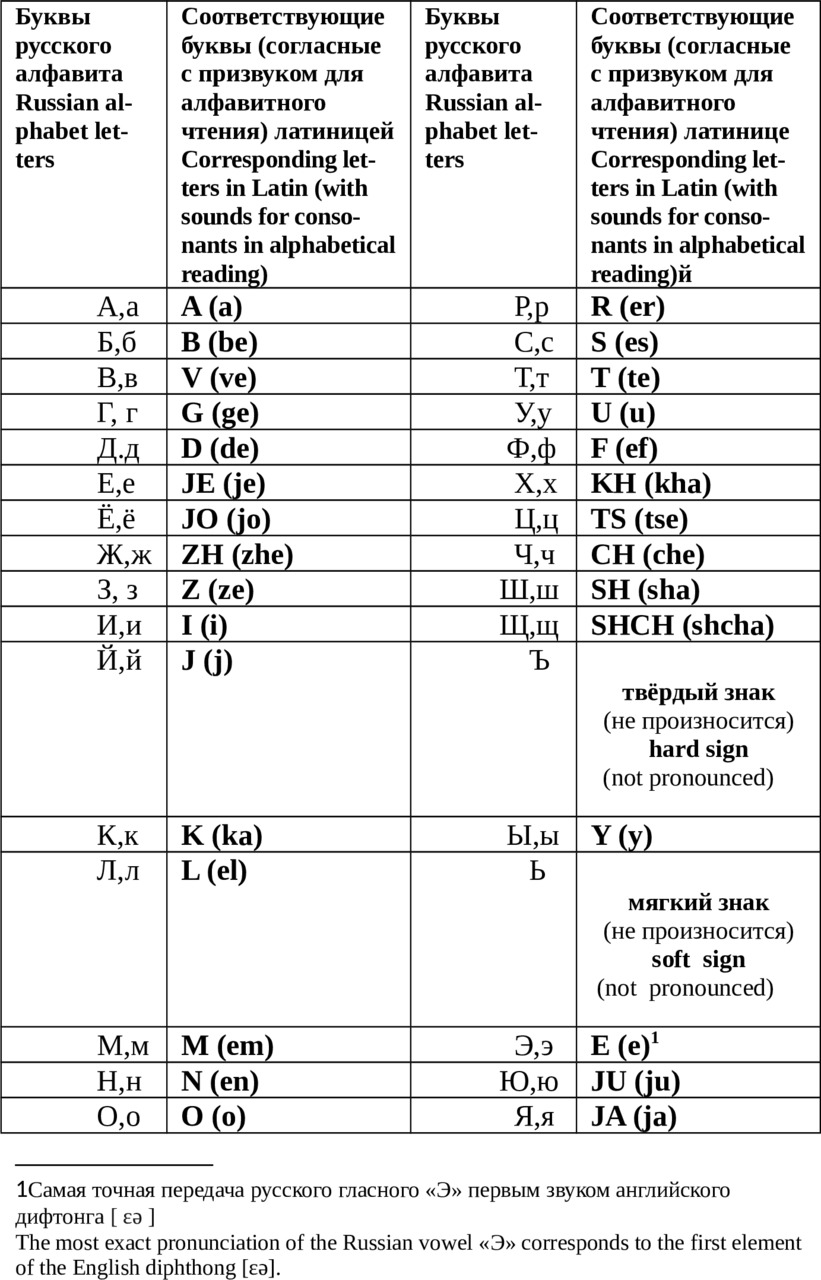

Mind! The consonants are given with an attached vowel only for alphabetic reading. Внимание! У согласных дан гласный призвук алфавитного чтения. Example Пример К (kа)
ИНОГДА В СРАВНЕНИИ ЗВУКОВ РУССКОГО ЯЗЫКА С ОПОРОЙ НА АНГЛИЙСКИЕ СЛОВА ДАЁТСЯ ТАКОЙ ВАРИАНТ.
SOMETIMES, IN COMPARING THE SOUNDS OF THE RUSSIAN LANGUAGE WITH THE SUPPORT OF ENGLISH WORDS, SUCH AN OPTION IS GIVEN.
Таблица 3
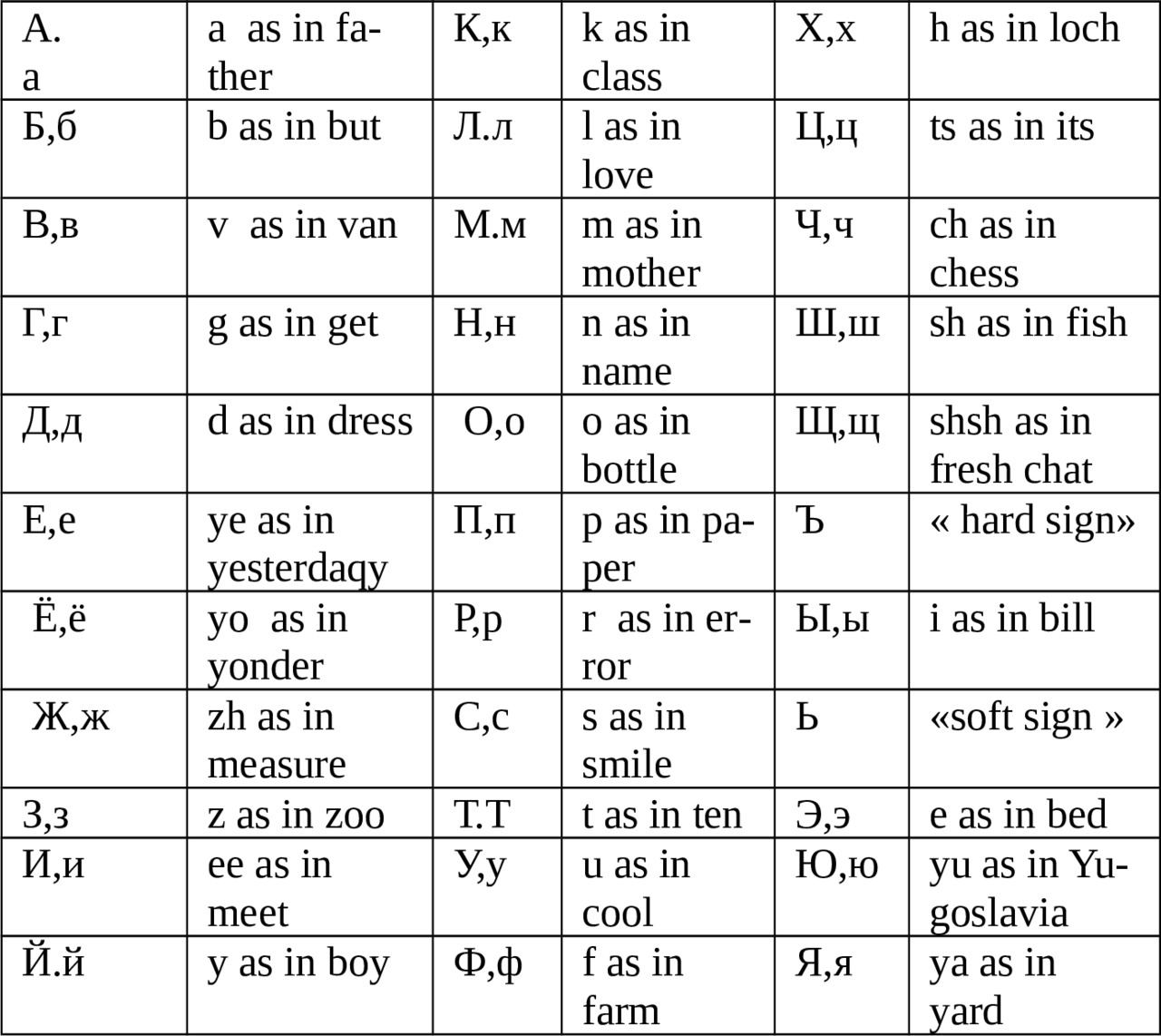
Поэтому автор настоящего учебника настойчиво отсылает к рекомендуемой транскрипции, приведённой автором первой. Она лучше для дифференциации русских звуков при их усвоении.
Therefore, the author of this textbook insists on the first recommended transcription given by the author. It is better for differentiating Russian sounds during their assimilation.
Гласные Vowels
В русском языке 6 гласных с одним звуком:
а [а],о [о], у [у], и [и], ы [ы],э [э].
There are 6 vowels in Russian with one sound:
а [а], оо [о], у [у],и [и], ы [ы],э [э].
Гласные буквы, которые обозначают два звука: Я [й’a], Ё [й» o], ю [й’y], Е [й’э].
Vowels with two sounds:
Я [й’a], Ё [й» o], ю [й’y], Е [й’э].
Согласные звуки Consonants
paired –парные
Б В Г Д З Ж voiced звонкие
П Ф К Т С Ш voiceless глухие
not paired — непарные
Л М Н Р Й voiced звонкие
Х Ц Ч Щ voiceless глухие
Примечание: Й условно упомянута среди согласных.
Note: Й is conventionally mentioned among the consonants.
Всегда твёрдые согласные Always hard consonants
ж, ш, ц
Всегда мягкие согласные Always soft consonants
ч, щ,
Сонорные Sonorous
Л, М, Н, Р.
В русском алфавите 33 буквы, твёрдый Ъ и мягкий Ь знаки не читаются, а влияют на произношение согласных.
The Russian alphabet has 33 letters, the hard sign Ъ and the soft sign Ь are not pronounced but influence on pronunciation of consonants.
Произношение согласных Pronunciation of consonats
Согласные твёрдые Consonants are ronounced as hard (перед before А, О, У, Ы, Э гласными vowels) и мягкие as soft (перед before И, Е, Ё, Ю, Я гласными vowels)
Таблица 4
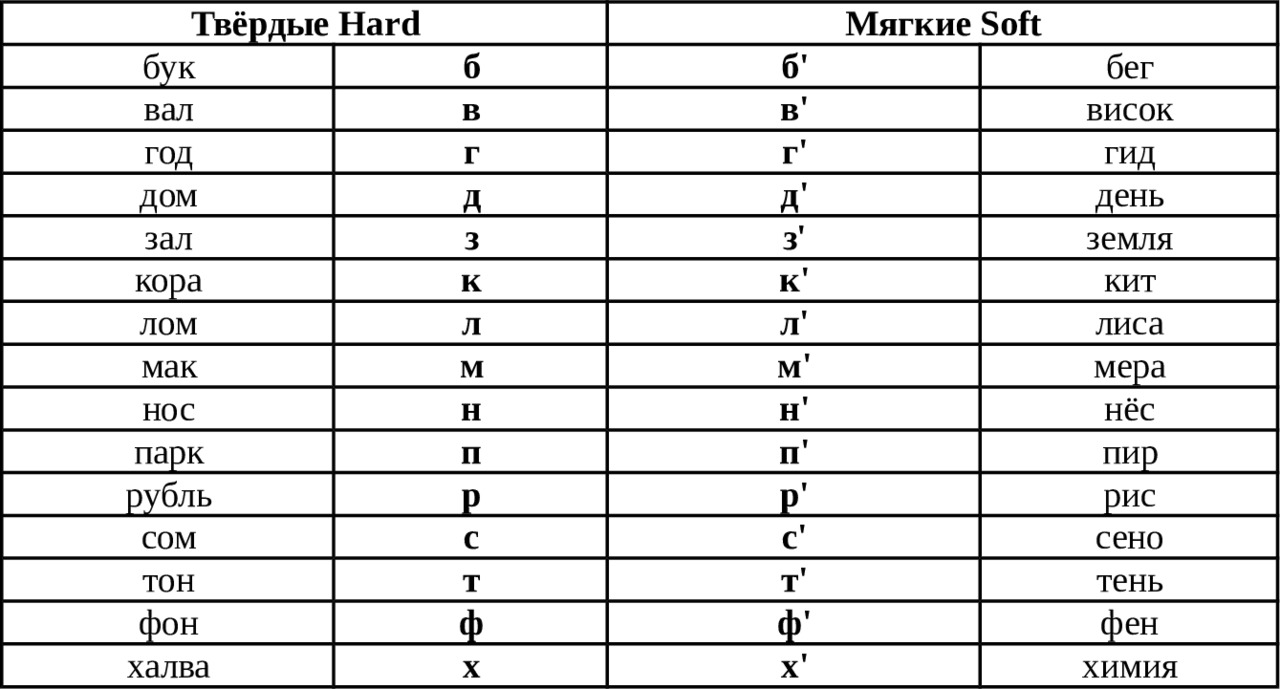
Примечание: знак ‘ вверху у согласной обозначает её мягкость.
Note: The «sign at the top of the consonant indicates its softness.
Примечание о русской транскрипции:
Note about Russian transcription:
1. Буква Й — занимает промежуточное положение между согласными и гласными, поэтому символически лучше выбрать знак [j] из транскрибационных знаков латинской транскрипции, и соответственно так передать четыре русские гласные с двумя звукамиЕ [je], Ё [jo], Ю [ju], Я [ja].
1. The letter Й occupies an intermediate position between consonants and vowels, therefore it is symbolically better to choose the [j] sign from the transcriptional signs of the Latin transcription, and, accordingly, to convey four Russian vowels with two sounds like that Е [je], Ё [jo], Ю [ju], Я [ja].
2. Тогда для Ы остаётся знак [y], а для И — [i], а различие этих гласных с трудом усваиваются носителями другого языка, вернее возникает трудность с их произношением, особенно в конце слов.
2. Then for Ы there remains the sign [y], and for И — [i], and the difference between these vowels is difficult for native speakers of another language, or rather there is a difficulty withpronunciation, especially at the end of words.
3. Транскрибационные латинские знаки ограничены в передаче разницы двух русских гласных Е и Э. Оба передаются знаком [e], лучше бы было использовать для Э первый знак из английского дифтонга [ɛə], тогда ясно различие между Е и Э, второй гласный шире.
3. Latin transcription signs are limited in conveying the difference between two Russian vowels E and Э. Both are conveyed by the [e] sign, it would be better to use the first sign from the English diphthong [ɛə] for Э, then the difference between E and Э is clear, the second vowel is wider.
Примечание: даже в латинской транслитерации русскими тоже встречаются варианты; транскрипция, в основном, нужна для написания русских имён, фамилий и географических названий, но не для запоминания русских слов.
Note: even in Latin transliteration, Russians also have variants; transcription is mainly needed for spelling Russian names, surnames and geographical names, but not for memorizing Russian words.
Таблица 5
Русская транскрипция — — — — — — — Зарубежная транскрипция
Russian transcription — — — — — — — — Foreign transcription
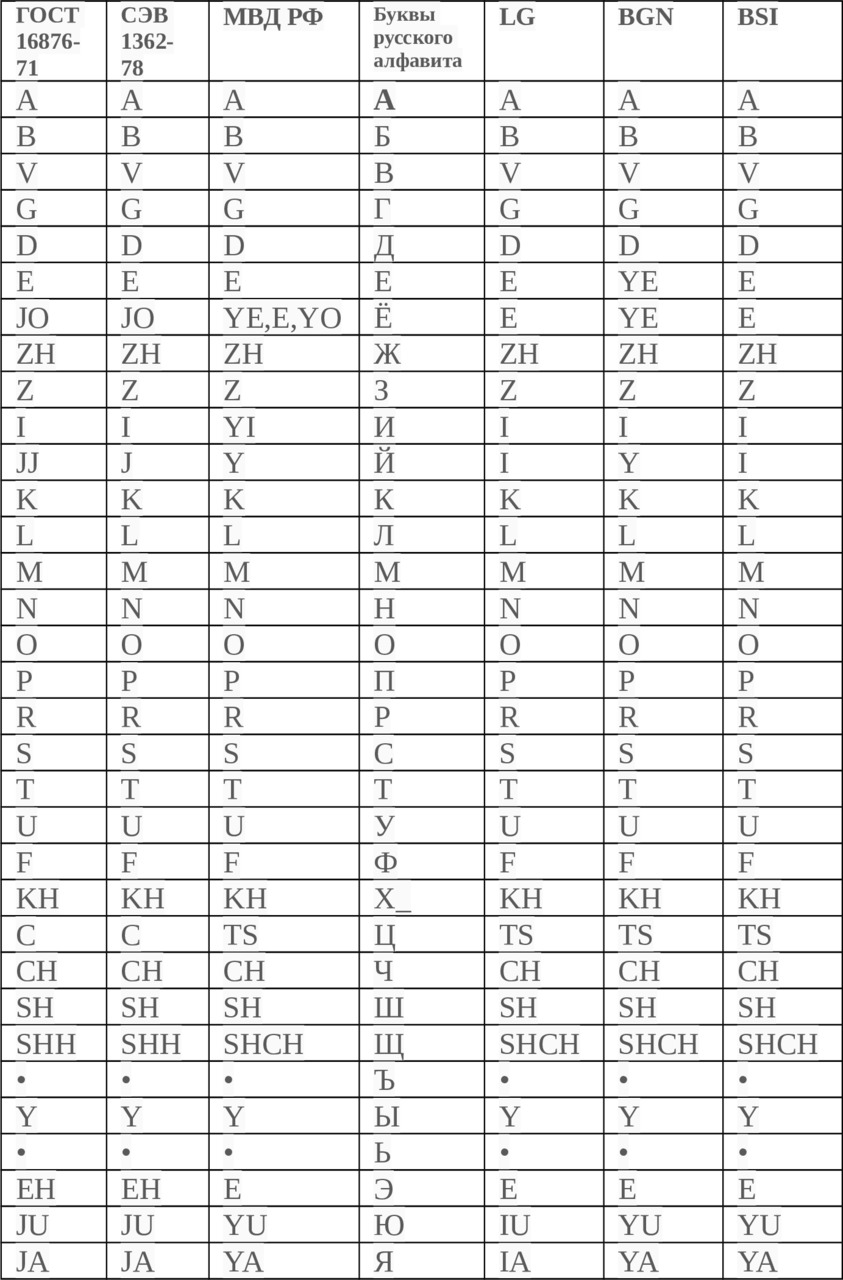
Правописание Ъ и Ь знаков
How to write correctly the sings Ъ and Ь
Ъ
— для отделения гласных to separate the vowels «Е, Ё,Ю,Я»
подъехать, съёжился, предъюбилейный, предъявить, объять, изъян
— для отделения приставок to separate prefixes
панъевропейский, фельдъегерь, двухъярусный, трёхъярусный, четырёхъязычный
— в иностранных словах in foreign words
адъютант, инъекция, субъект
Ь
— в конце слов, чтобы обозначить мягкость согласного
— at the end of words to soften the final consonant
голубь, тетрадь, грязь, семь, жаль, конь
— существительные женского рода in nouns of female gender
рожь, мышь, ночь, печь
— у глаголов in verbs
а) в инфинитиве in infinitive
читать, писать, решать, помогать, мыть, сечь
в инфинитиве также перед возвратной частицей «-ся»in infinitive also before the reflexive particle «-ся»
обжечься, обриться, опозориться
б) у глаголов настоящего времени 2-го лица единственного числа
in verbs of the Present tense 2-nd person singular
ты несёшь, съешь, помогаешь, стираешь, читаешь, делаешь
в) у глаголов простого будущего времени, 2-е лицо единственное число
in verbs of Future tense simple 2-nd person singular
ты пойдёшь, принесёшь, приедешь, поешь, съешь
г) повелительное наклонение inimperative
(при обращении на «ты») — (при обращении на «вы» polite form and to address a group of people)
(не) трать — — — — — — — — — — — — — — — (не) тратьте
(не) плачь — — — — — — — — — — — — — — — (не) плачьте
(не) ешь — — — — — — — — — — — — — — — — (не) ешьте
(не) брось — — — — — — — — — — — — — — — (не) бросьте
д) у некоторых наречий in some adverbs
невмочь, прочь, навзничь, настежь, наотмашь, сплошь
е) частицы in particles
лишь, бишь, ишь
Ь пишется is written
— для отделения гласных to separate the vowels «Е,Ё,И,Ю,Я»
портьера, курьёзный, лисьи, вьюга, бурьян
— перед буквой «О» в иностранных словах before the letter «О» in foreign words
бульон, павильон, почтальон, синьор, шампиньон
— в числительных в середине слова и в конце in some numerals in the middle of the word and at the end
пятьдесят, шестьсот, семьсот, восемьсот, девятьсот; пять, семь.
— при смягчении согласной «л» to soften the consonant «л»
пальтишко, обстоятельства, приятель, боль
— при смягчении согласной внутри слова to soften the consonant in the middle of the word
ведьма, просьба, письмо, раньше
ПРАВИЛА ЧТЕНИЯ RULES OF READING
Прочитайте правильно Read correctly
1) Оглушение в конце слова making a consonant voiceless at the end of words
Снег, вокруг, круг, рукав, многороз, пятьраз, перед, берег, стаж, порог, рёв, зов, ров, ёжь, город, голод, повод, багаж, мороз, гипноз, рог, стог, Бог, луг, молод, плод, труд, глаз, водолаз, паровоз, заказ, арбуз, пруд, виноград, поезд, морковь, пирог, гараж, муж, нож, этаж.
1-а) Двойное оглушение Double making a consonant voiceless
дождь
Перед глухими согласными, как внутри слова так и между словами.
Before voiceless consonants both in the middle of the word and between words.
Водка, селёдка, бумажка, подставка, буковка, берёзка, порожки, подкова, низ платья, под полом, подпорка, подсказка, сказка, подставка, гладкий, шубка, бровки, головка, подтекает, вчера.
2) Озвончение согласных Making consonants voiced
Перед звонкими согласными, как внутри слова так и между словами.
Before voiced consonants both in the middle of the word and between words.
Сделать, сделал, сбоку, отбой, с другом, сбить, отдых.
3) Уподобление Assimilation: первый звук уподобляется второму –the first sound is adapted to the second (in bold type)
Разжечь, счёт, расщедрился, подчистить, с жуком, из шерсти, сшить, сжать, без жалости, возчик, лётчик, молодчик, мужчина, резчик, жёстче.
4) ЧН
[шн] — — — — — — — — — — — [ч‘н]
конечно — — — — — — — — — - бесконечный
скворечник — — — — — — — —беспечный
булочница — — — — — — — — обеспеченный
яичница — — — — — — — — — - удачный
скучно — — — — — — — — — — быстротечный
нарочно — — — — — — — — — -брачный
прачечная
5) Выпадение согласных Consonants are dropping out
Обычно выпадают согласные в таких сочетаниях
Consonants drop out in such combinations
стн, нтск, стл, ндск, здн, рдц, лнц, вств, лвств
Властный, сердце, поздно, солнце, завистливый, чувство, шестьсот, голландский, местный, гигантский, счастливый, шотландский, праздник, безмолвствовать.
6) Отдельные слова Special cases
СЧ> [Щ]
Счастливый, счастье, счёт, счётчик.
ГК> [Х’К»]
Лёгкий, мягкий, легче, мягче.
ДС, ТС, ТЬСЯ> [Ц]
Детский, городской, одеваться, умываться, бояться, развлекаться,
рваться, годиться, боится, бояться.
ЧТ> [ШТ]
Что, чтобы,!нéчто,!ничто.
ОГО> [ОВО], но! ДОРОГО
Сегодня, ничего, синего, белого, всего хорошего, 5минут четвёртого, 10 минут двенадцатого, доброго утра, первого мая.
УДАРЕНИЕ В РУССКОМ ЯЗЫКЕ
ACCENT IN THE RUSSIAN LANGUAGE
Ударение в русском языке разноместное, оно может падать на любой слог. Для проверки можете произнести слово вслух и попробовать выделить гласную, и ударение может стать на нужное место. При изменении грамматической формы ударение в слове может передвинуться. Для проверки ударения пользуйтесь Орфоэпическим словарём. Ударение всегда падает на букву Ё (однако иногда в печати точки над Ё не ставятся). Эту букву даже запечатлели в памятном знаке в городе Ульяновск.
The stress in Russian has no fixed places, it can fall on any syllable. To check, you can pronounce the word out loud and try to highlight the vowel, and the stress can fall on the right place. When the grammatical form changes, the stress of the word may move. Use the Orthoepical Dictionary to check stress. The stress always falls on the letter Ё (however, sometimes dots are not put over Ё in print). This letter was even captured in a memorial sign in the city of Ulyanovsk.
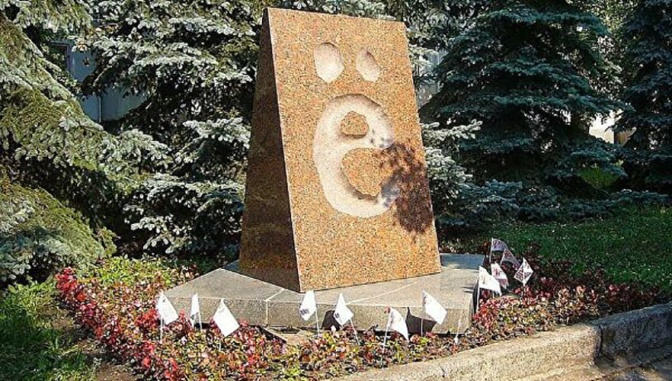
В 1997 году 200 лет появления буквы Ё в печати.
В 2005 г. Памятный знак установили в Ульяновске.
In 1997, 200 years of the appearance of the letter Ё in print.
In 2005 a memorial sign was installed in Ulyanovsk (Рис. 8)
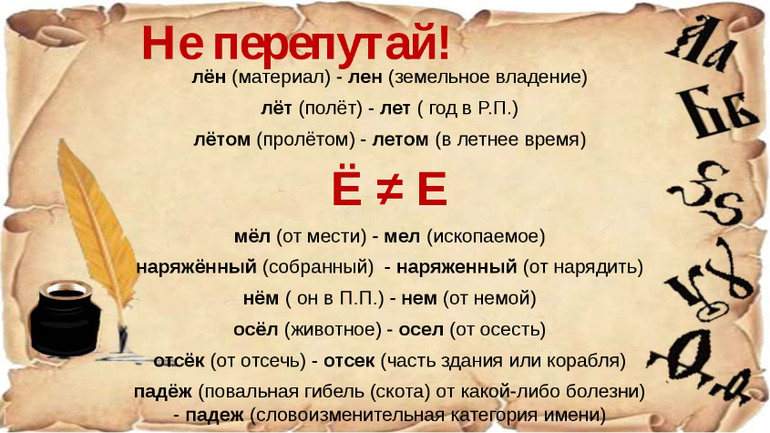
Потренируйтесь в постановке ударения
Practise the stress (accent)
Самолёт, вертолёт, корабль, грузовик, автомобиль, автобус, троллейбус, полотенце, раковина, потолок, календарь, холодильник, телевизор, гостиная, прихожая, квартира, кастрюля, продукты, колбаса, мороженое, тарелка, отбивная, бутылка, сковорода.
ДЛЯ РАЗВИТИЯ ДИКЦИИ ПОЛЕЗНЫ СКОРОГОВОРКИ
TO DEVELOP YOUR DICTION TRAIN YOUR TONGUE THROUGH TONGUE TWISTERS
Скороговорки со звуком «ч»
— Часовщик, прищурив глаз, чинит часики для нас.
— У нас в печурочке золотые чурочки.
— Синичка, синичка — воробью сестричка.
— Черепаха, не скучая, час сидит за чашкой чая.
— Чудак под диванчик прячет чемоданчик.
А также скороговорка в форме стихотворения:
Четверть часа чиж чижихе
Пел частушки на Плющихе.
Чёрный кот, большой чудак,
Влез послушать на чердак.
Скороговорки со звуком «ш»
— Шла Саша по шоссе и сосала сушку.
— Саша шапкой по ошибке шишку сшиб.
— Кукушка кукушонку купила капюшон. Надел кукушонок капюшон, как в капюшоне он смешон.
Скороговорки со звуком «щ»
— Кощея щами не угощают.
— Хищник в роще рыщет — хищник пищу ищет.
— Щенок в чащу дощечку тащит.
— Щеткой чищу я щенка, щекочу ему бока.
А вот комбинированная скороговорка для тренировки двух звуков «щ» и «ш»:
В роще травы шевеля, мы нащиплем щавеля.
Скороговорки на тренировку «л»
— Лапти лыковые, лыки липовые.
— Наш Полкан попал в капкан.
— Лилии полили ли, иль увяли лилии?
Скороговорки на тренировку «р»
— На дворе трава, на траве дрова, не руби дрова на траве двора!
— Прорубь рубили — рыбку ловили.
— Ехал грека через реку, видит грека — в реке рак. Сунул грека руку в реку, рак за руку грека цап.
— Карл у Клары украл кораллы, а Клара у Карла украла кларнет.
РАЗНЫЕ
Выдра из ведра выпрыгнула,
Воду из ведра выплеснула,
Выпрыгнуть-то она выпрыгнула,
Выплеснуть-то она выплеснула,
А обратно впрыгнуть да вплеснуть
Не смогла!
Гравёр Гаврилов выгравировал гравюру.
Арина грибы мариновала,
Марина малину перебирала.
Валин валенок провалился в прогалинок.
Валерий кавалерию раскрасил акварелью
Карьером кавалерия скачет у Валерия.
1.2. Основы грамматики: существительное, род,
прилагательное, наречие, числительное (счёт, даты, время), предлоги, падежи существительного, повелительное
наклонение, время действий, изменение глаголов.
1.2. Basic grammar. Morphology: noun, prepositions,
adjective, numerals (counting, dates, time), pronoun, adverb,
verb. Syntax. Punctuation.
Существительное Таблица 6
NOUN
РОД ИМЁН СУЩЕСТВИТЕЛЬНЫХ
GENDER OF NOUNS
ОКОНЧАНИЯ ENDINGS ПРИМЕРЫ EXAMPLES
Three types 1-st,2-nd, 3-d
Первое склонение
мужской род юноша, дядя
— а, -я
женский род птица, земля
Второе склонение
мужской род — /-ь отец день
средний род -о. –е зерно, счастье
Третье склонение
женский род -ь дочь, рожь
Примечание: слова к 6 Таблице words for Table 6
Мужской род male gender
Женский род female gender
Средний род neutral gender
первое/второе/третье склонение
the first/the second/the third declination
Примечание: Окончание на «ь» характерно для существительных женского рода 3-го склонения, однако несколько существительных мужского рода оканчиваются тоже на «ь» и это
2-е склонение: преподаватель, день, конь, пень, картофель, рубль, словарь, дождь, медведь. Не путать!
Note: «Ь» in the ending is typical for feminine nouns of the 3rd declination, but several masculine nouns also end in «Ь»and this is the 2nd declination: преподаватель, день, конь, пень, картофель, рубль, словарь, дождь, медведь. Don’t confuse!
ПАДЕЖИ CASES
Контрольные направляющие слова
Guiding words
именительный кто? что?
nominative case
родительный кого? чего? НЕТ…
genitive case
дательный кому? чему? ДАЛ…
dative case
винительный кого? что? ВИЖУ…
accusative case
творительный кем? чем? ИДУ С…
instrumental case
предложный о ком? о чём? ПИШУ О…
prepositional case
Окончание трёх склонений существительных в единственном числе
Endings of the three declinations of nouns in the singular
Таблица 7
Падеж/ Case
1 склонение — — — — /2 склонение — —— — /3 cклонение
женский род мужской род/мужской род средний род/ женский род
И -а, -я, -а, -я///////////////////// -ь, — -о, -е//////////////////// -ь
Р — ы, -и, -ы, -и///////////////////-а, -я -а, -я/////////////////// -и
Д -е, -е, -е, -е///////////////////// -у, -ю -у-ю ///////////////////-и
В -у, -ю -у, -ю,///////////////////// -, -я -о, -е ///////////////////-ь
Т -ой, -ей, -ой, -ей ///////////////-ом, -ём, -ом, -ем/////////// -ю
П -е, -е, -е, -е/////////////////////// -е, -е, -е, -е//////////////// -и
Пример Example
И. мама папа ////////////////////////конь поле///////////////// печь
Р. мамы папы ///////////////////////коня поля /////////////////печи
Д. маме папе//////////////////////// коню полю////////////// печи
В. маму папу /////////////////////////коня поле //////////////печь
Т. мамой папой////////////////////// конём полем////////// печью
П. маме папе//////////////////////// коне поле/////////////// печи
Склонение существительных с предлогами (соответствие по падежам) и вопросами Reference of prepostitions to cases
Кто? — для одушевлённых Who?−for live things
Что? — для неодушевлённых What? — lifeless things
Склонение существительных с предлогами (соответствие по падежам) и вопросами
Declination of nouns with corresponding prepositions (prepositions are chosen for each case) and questions
Таблица 8
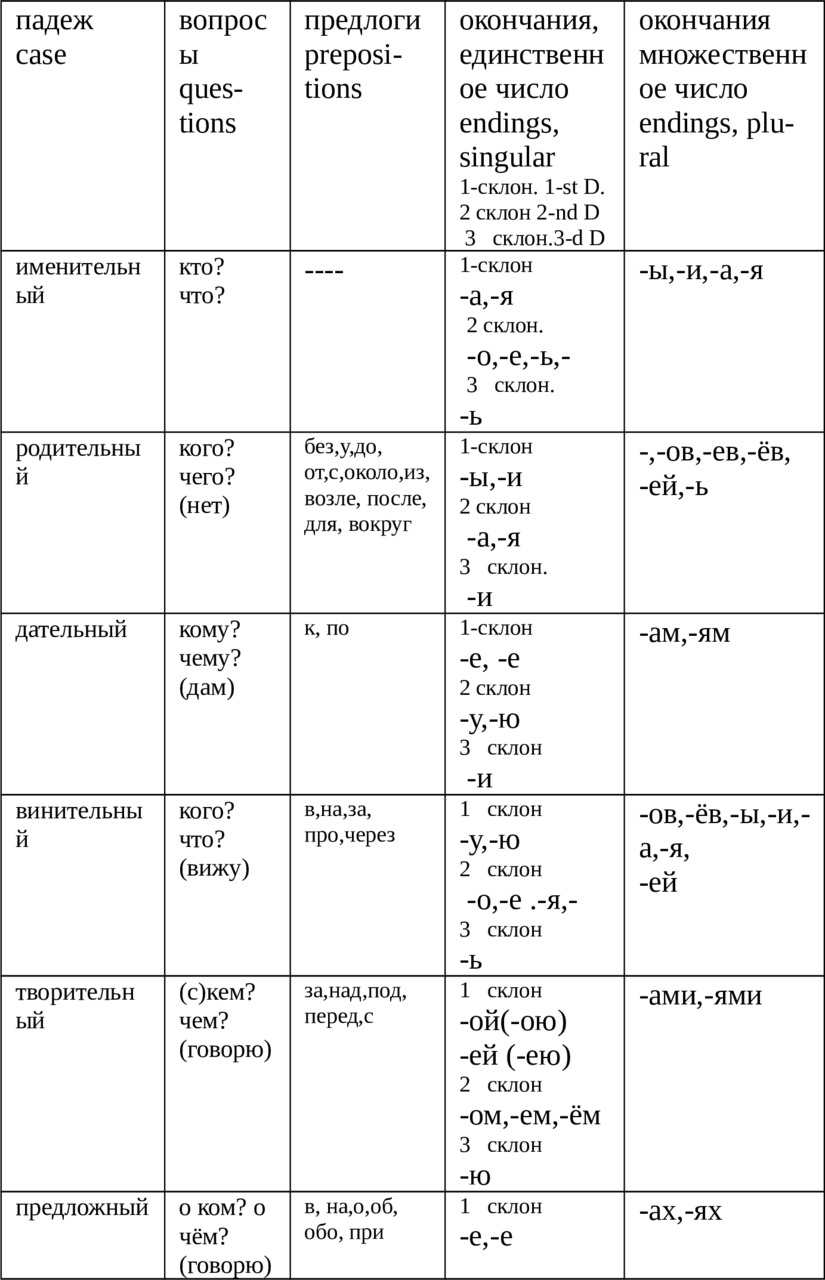

Множественное число Plural
Окончания существительных во множественном числе Endings of nouns in plural
— и (-ы) -а (-я) -ие (-ые)
Примеры Examples: тучка — тучки, сосна — сосны, дом — дома, вексель — векселя, животное — животные, пресмыкающееся — пресмыкающиеся.
Иногда изменяется ударение: Sometimes the stress is moved otherwise:
лес — лесá, дéрево — дерéвья
Изменения в основе: Changes in the base:
сын — сыновья, дочь — дочери, муж — мужья, стул — cтулья, котёнок — котята
Или замена слова: Substitution by another word:
человек — люди, ребёнок — дети.
В русском языке все существительные можно разделить на три группы.
In Russian all nouns can be divided into three groups according to the category of number.
√ существительные, которые изменяются по числам nouns have the category of number
рука — руки, брат — братья, окно — окна
√ существительные, имеющие только единственное число only singular
мука, любовь, бархат, олово
√ существительные, имеющие только множественное число или парные only plural or paired nouns
сливки, шахматы, брюки, ножницы
Declination of nouns in the plural
Для таблицы For the table единственное- множественное
Singular -Plural
1—st declination/////// 2-nd declination/////// 3-d declination
female //////////////////////male//////////////////// female
сестра-сёстры/////////// слон-слоны //////////степь-степи
речка-речки//////////// куст-кусты/////////// мышь-мыши
стена-стены /////////////соловей-соловьи
лиса-лúсы////////////////луч-лучи
земля-земли///////////////////neutral
male///////////////////////////// село-сёла
папа-папы /////////////////////поле-поля
Таблица 9
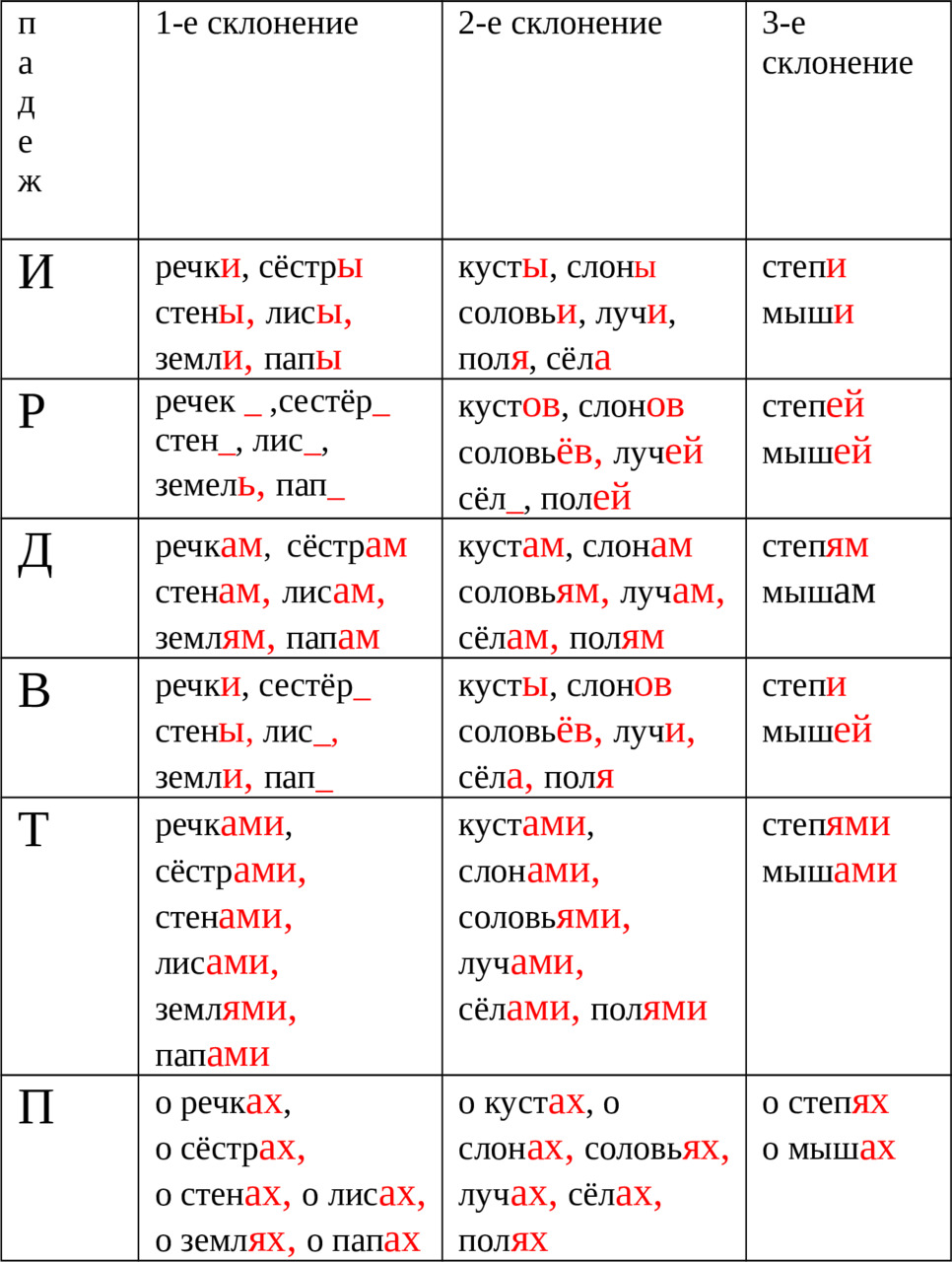
Предлоги Prepositions
Пространственные предлоги Prepositions of space
в, до, из-за, за, к, над, под, перед, у, через, возле, мимо, около и пр.
— Выскочил из-за поворота;
— притаился за сараем;
— вьются над липой;
— добежать до финиша;
— задержаться перед картиной;
— стоит у дома;
— поставить под ноги;
— перепрыгнуть через лужу;
— пройти мимо ворот;
— сидеть около костра;
— остановиться возле моста;
Временные предлоги Prepositions of time
в, к, до, по, через, после, в течение, в продолжение, в заключение
— встретимся через неделю;
— посмотреть фильм до конца;
— занятия с сентября;
— зайти после звонка;
— узнать перед Новым годом;
— изучать в течение месяца;
— хмуриться в продолжение разговора;
Причинные предлоги Prepositions of cause
из-за, от, по, ради, благодаря, в силу, ввиду, вследствие
— отказаться ради неё;
— покраснеть от гнева;
— не явиться по болезни;
— ввиду заморозков спешить с уборкой овощей;
— благодаря этим свойствам;
— в силу неприязни;
— вследствие шторма;
Целевые предлоги Prepositions of purpose
за, для, по, на, к, ради, в целях, с целью
— приобрела для занятий;
— пришёл за вознаграждением;
— сделать ради будущего;
— с целью укрепления связей;
Объектные предлоги Prepositions referring to an object
о (об/обо), про, насчёт
— волнуется о здоровье ребенка;
— размышляет об явлении;
— рассказать про поездку;
— узнать насчёт отпуска;
Уступительные предлоги Prepositions of concession
вопреки, несмотря на
— вопреки инструкции;
— несмотря на запрет;
Сравнительные предлоги Prepositions of comparison
с, вроде, наподобие
— тыква с бочонок;
— речка наподобие голубой ленты;
— животное вроде сурка.
Примечание: предлоги — это служебные слова, поэтому точно их перевести с одного языка на другой трудно. Лучшая практика — это чтение текстов. Note: prepositions are service words, so it is difficult to accurately translate them from one language to another. The best practice is reading texts.
Скорректируйте значение предлогов по картинкам.
Use pictures to understand prepositions better.
Предлоги местоположения Prepositions of place
Рисунок 10 Рисунок 11
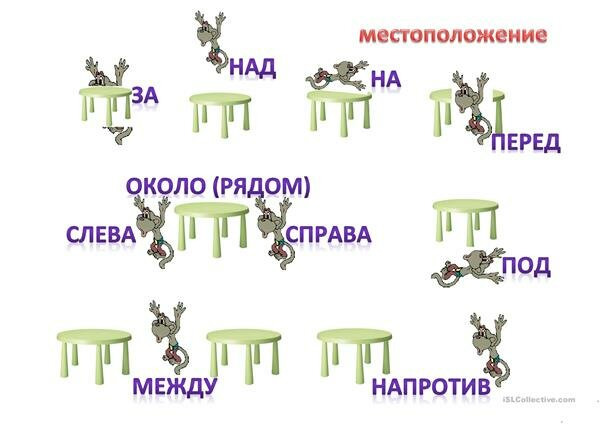
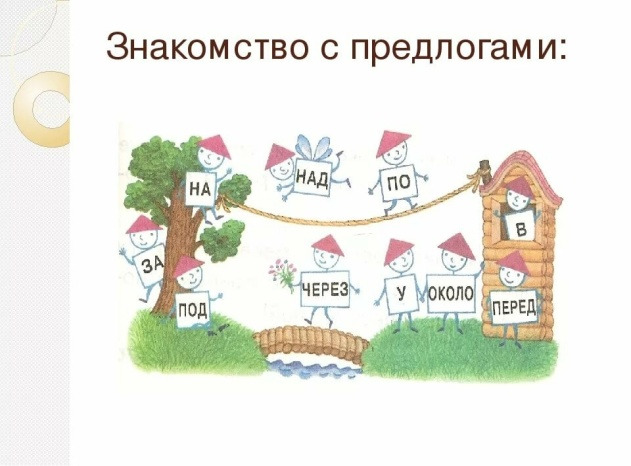
Повторите в другой позиции Repeat the other way
Рисунок 12 Рисунок 13
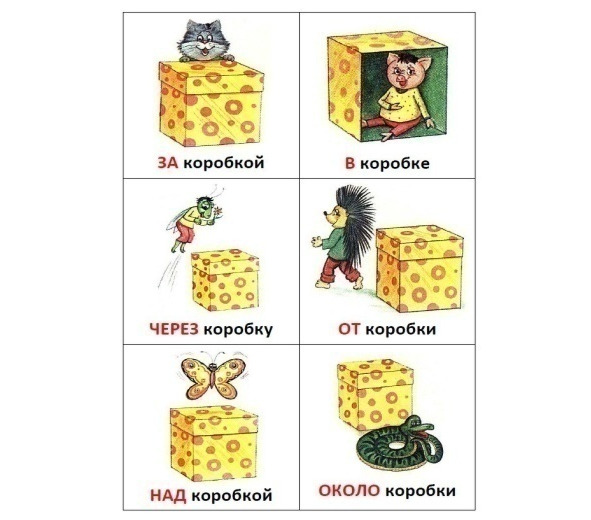
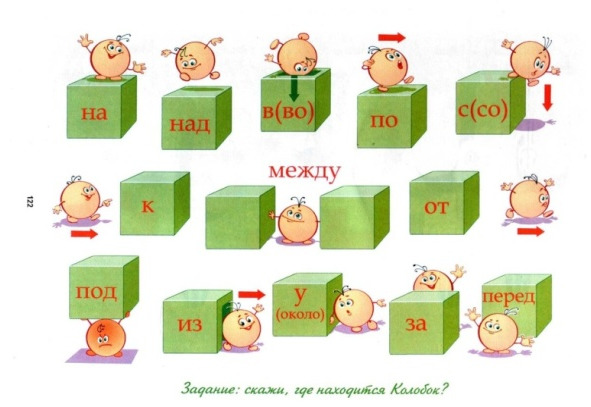
Символическое значение предлогов Symbolic meaning of prepositions
Рисунок 14
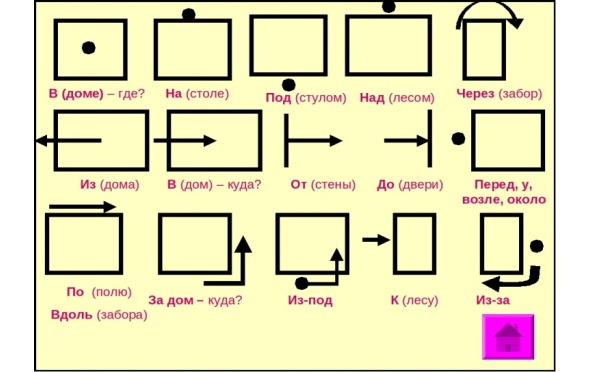
Примените предлоги для описания движений
Prepositions of movement
Рисунок 15
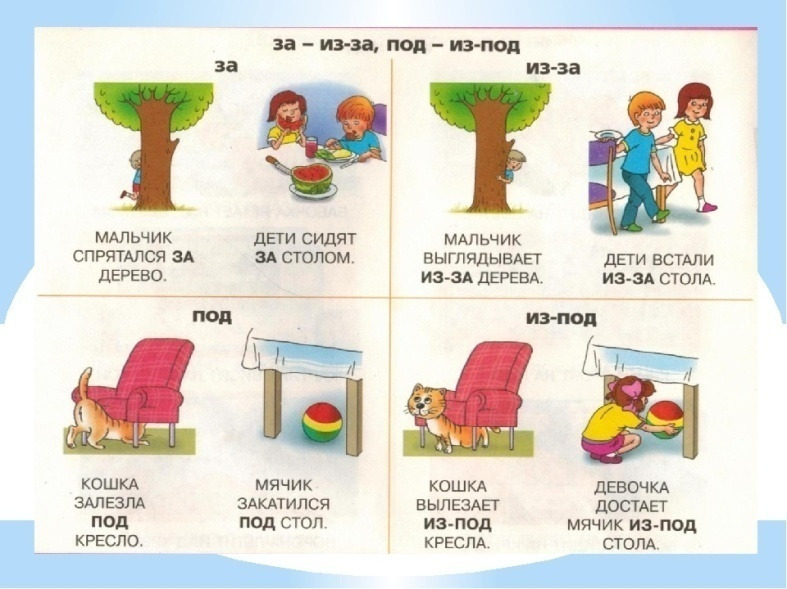
Рисунок 16
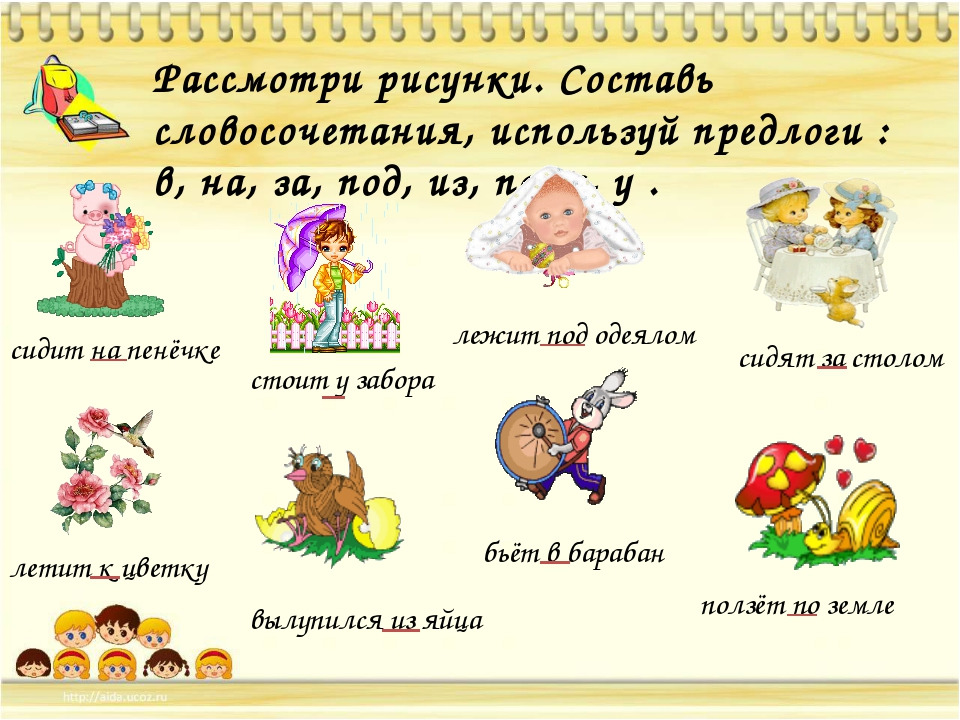
Составьте предложения с показанными предлогами.
Make up sentences with prepositions above (several variants for some sentence).
You may change the ending!
— Мальчик сидит… компьютером.
— … дома есть большой парк.
— … снегом появляются первые ростки травы весной.
— … дома вышел человек.
— Кто-то стучит… дверь.
— Мама подошла… ребёнку.
— Бабушка сидит… скамейке… дома.
— … реке плывёт пароход.
Теперь придумайте свои предложения с предлогами.
Make up your own examples with prepositions.
Примените предлоги для описания картинок.
Describe pictures using prepositions.
Прилагательное Adjective
Изучите окончания в зависимостиот рода. Таблица 10
Study dependence of endings from gender.
Мужской род Male /Женский род Female /Средний род Neutral
КАКОЙ? ///////////КАКАЯ? /////////////КАКОЕ?
смешной гном ////////смешная сказка ///////смешное лицо
добрый дед/////////// добрая фея///////////// доброе дело
синий сундук///////////синяя краска//////////// синее море
ОКОНЧАНИЯ ENDINGS
— ОЙ, -ЫЙ, -ИЙ //////-АЯ, -ЯЯ/////////////-ОЕ, -ЕЕ
Потренируйте окончания прилагательных, подбирая к ним существительное Practise gender changing of adjectives bymatching adjectives to nouns
Прилагательные Adjectives: красный, мягкий, смешной, популярный, любимый, интересный, лёгкий, новый, старый, вкусный, приятный, разноцветный, круглый, маленький, кислый, добрый, злой, зелёный, металлический, грустный, счастливый.
Существительные Nouns: ребёнок, женщина, скамейка, яблоко, окно, мужчина, шар, обед, девочка, учитель, трава, хулиган, забор, мама, фрукт, дом, автомобиль, инструмент, рассказ, песня, игрушка, сумка, писатель, книга, новость.
Изменение окончаний прилагательных по падежам
Case changing of endings in adjectives
(two factors are combined: gender and case)
Примечание: «одуш.» -одушевлённые, «неодуш.» -неодушевлённые
Note: «одуш.» — animal, «неодуш.» — inanimal
Мужской род Единственное число Male Singular Таблица 11
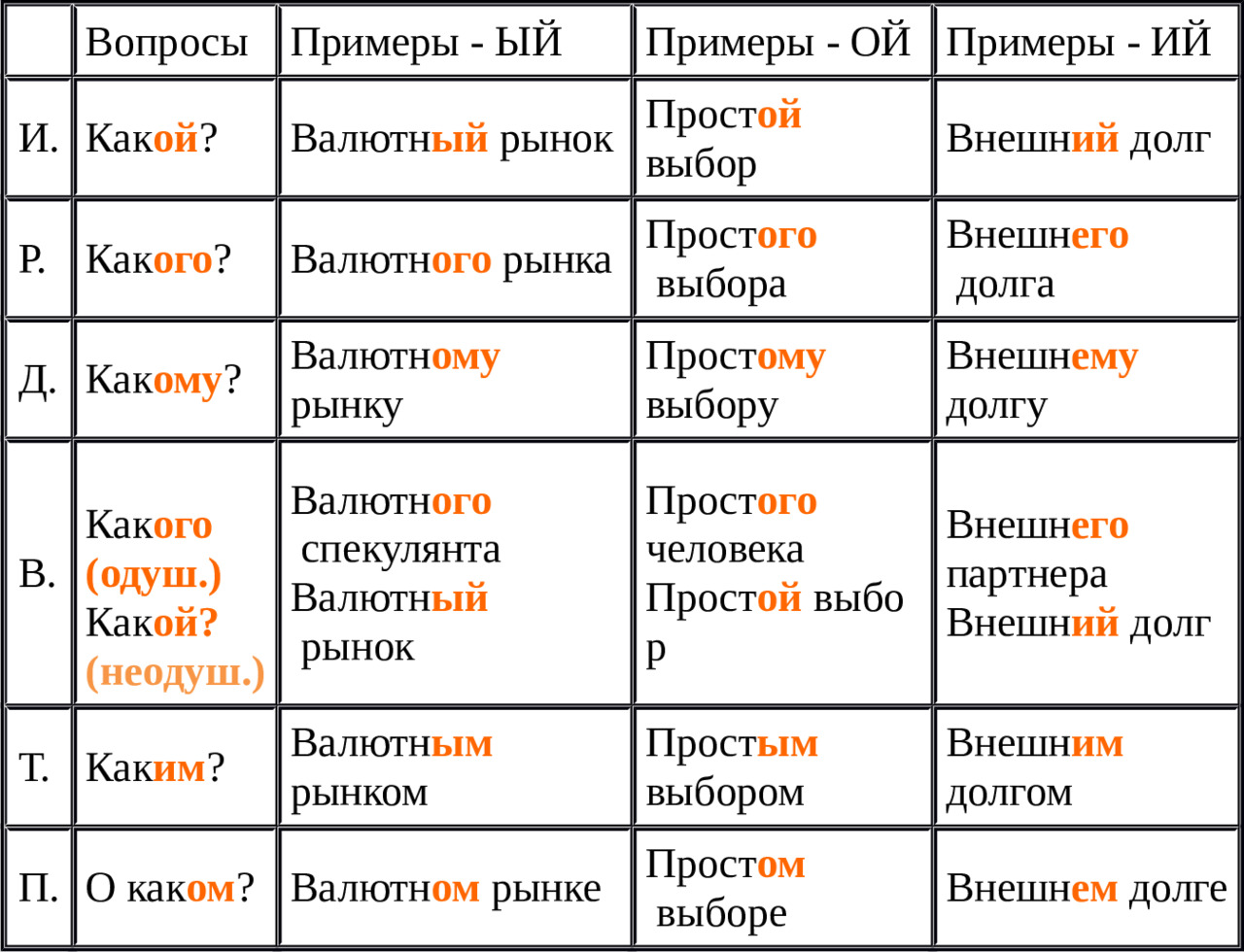
Женский род Единственное число Female Singular Таблица 12
Бесплатный фрагмент закончился.
Купите книгу, чтобы продолжить чтение.
